Cruise Ship Engine Room (Everything You Want to Know)
Disclosure: This post may contain affiliate links. We may receive compensation when you purchase via my links at no cost to you. See my disclosure for more information.
Cruise ships require a lot of power to sail and operate. The cruise ship engine room is both mysterious and fascinating because it’s hidden from passengers.
Passenger ships have come a long way from sails and steam engines. Modern cruise ships use diesel-electric engines, while newer cruise ships are moving towards more environmentally friendly solutions like liquified natural gas.
Here’s everything you need to know about a cruise ship’s engine room.
Table of Contents

Where is the Cruise Ship Engine Room?
The engine rooms on cruise ships are located on the lower decks, between the midship and the aft. The engines aren’t quite at the back of the vessel but closer to midship.
There are several reasons for keeping the cruise ship engine room away from passenger areas.
- Stability : Placing the engines and heavy equipment below sea level helps keep the ship stable and prevents cruise ships from tipping over .
- Noise : Engine rooms are extremely noisy. Naval engineers compensate by incorporating sound reduction features and noise dampeners. However, the sound and vibration wouldn’t be pleasant for cruise ship passengers.
- Security : The engine room spaces are in crew-only areas for safety and security purposes.
Most of the heavy machinery on a cruise ship is located on the lower decks, just above the keel. The positioning of the engine room, other machines, and technical equipment give the massive vessels a lower center of gravity.

Although you might envision the engine room as a massive open room running the ship’s length, the lower decks are divided into several water-tight compartments. One compartment may house the cruise ship water fresh water systems , another for the main engines, and another for the air conditioning.
The division of the engine room into separate compartments is for safety. Dividing the engine room into different containers makes it easier for the ship to contain the damage if there’s a fire or leak in the hull.
Cruise ship fuel tanks are also on the lower decks, but they are kept separate from the main engines.

Crew members can monitor the ship’s systems from the engine control room. From the operation control center, crew members monitor the ship’s systems and act as a central area for maintaining the technical equipment on the cruise ship.
Every piece of equipment can be monitored from the engine control room to ensure the cruise ship runs smoothly.
The room is monitored 24/7 by watchkeeping teams. Each crew member is assigned specific machinery. For example, one person may be responsible for the freshwater generators and water pumps and another for the fuel oil systems.
How Big is a Cruise Ship Engine?

A cruise ship engine room spans several decks and holds the ship’s engines, fuel tanks, water systems, generators, control room, engine workshop, air conditioning, and other essential navigation systems.
Modern diesel-powered cruise ships have between four to six medium-speed (500 revolutions per minute) engines . Each engine can generate upwards of 25,000 horsepower or nearly 18.5 megawatts.
The engines on a cruise ship can be up to 45 feet long, 27 feet high, and weigh up to 275 tons .
These massive engines can propel cruise ships at an average speed of 18-22 knots .
Cruise Ship Engine Technology
Cruise ship engine technology has evolved from wind and sails to newer liquified natural gas technology.
We’ll cover some of the most popular technologies used by cruise ships.
Steam Engines

When the cruise industry began in the mid-1800s, vessels were propelled by steam engines.
Steam engines had boilers that used wood for fuel. Later steam engines used coal.
The boiler produced steam which created pressure in a pressurized system. The pressure moved pistons which drove the propeller shaft.
The Titanic was powered by two huge triple-expansion steam engines and a small propeller. ( Source )
Diesel Engine s

Diesel engines propel most modern ships. Cruise ships may have four to six medium-speed (500 rpm) engines producing 8-10MW each .
Diesel engines work on the same concept as steam engines. Rather than steam, the ignition of diesel fuel pushes the pistons up and down, turning the crankshaft attached to the propeller shaft.
Many of today’s diesel-engine cruise ships also employ a shaft generator to generate electricity for shipboard services, like lighting.
A shaft generator converts the circular motion of the propeller shaft into electricity. However, shaft generators only operate when the ship is moving. And can’t generate electricity while docked in port.
Diesel-Electric Cruise Ship Engines

Almost all new diesel-powered cruise ships use diesel-electric engines.
The engines work the same as a traditional diesel engine, but rather than connecting to the propeller shaft – diesel-electric engines connect directly to large generators .
A diesel-electric engine has one job, generating electricity.
The electricity produced by the engine is used to power the ship’s propellers.
These engines provide greater efficiency than traditional diesel engines.
While connected to a generator, the engines can run at their most efficient settings regardless of the travel speed . Whether the ship is sailing at 10 or 20 knots, the engines can operate a peak efficiency.
Diesel-electric engines are popular because of their ease of control, low noise, minimal vibration, and relatively compact size compared to other forms of propulsion.
Marine vessels that run on diesel power must carry exhaust-treatment systems and catalytic-reduction equipment to reduce the environmental impact of the ship.
Gas-Turbine Power System

Royal Caribbean Group was the first company to experiment with gas-turbine systems.
Compared to diesel engines, gas turbines offer several advantages, including:
- Lower environmental impact.
- More reliable.
- Take up less space.
- Gas engines require a smaller maintenance crew and less inventory.
The heat generated from the engine is recovered and used to produce electricity for other onboard systems, such as air conditioning and water heating.
Despite their advantages, gas propulsion is not widely used in the cruise industry. Gas-powered ships are faster, but most cruise ships don’t travel faster than 22-25 knots .
Diesel engines have greater fuel efficiency at slower speeds , and the high gas price compared to diesel makes them more costly to operate.
LNG Powered Ships

Many new cruise ships are propelled by liquified natural gas (LNG).
LNG is the cleanest fossil fuel currently produced. According to Cruise Critic , LNG-powered cruise ships can “reportedly reduce sulfur emissions by as much as 99 percent and nitrogen oxide emissions by up to 85 percent.” LNG can reduce carbon emissions by up to 20 percent .
The special engines of LNG-powered cruise ships use natural gas cooled to approximately -260°F. Once cooled, the liquid form of natural gas is about 600 times denser than natural gas , making it easier to transport.
Carnival Cruise Line announced the first LNG-powered vessels in 2015, using a “dual fuel” design. The ships can burn both liquified natural gas and marine fuel, reducing the required fuel storage space.
AIDAprima became the world’s first LNG-powered cruise ship on her debut in 2016.
Natural gas is purer, cleaner, more efficient, and cheaper than other fossil fuels . But it’s a relatively new technology, and not all ports have the facilities for refueling LNG-powered ships.
Because natural gas burns cleaner than other fossil fuels, the engines require less maintenance. But LNG has a lower fuel density than diesel, so LNG vessels need fuel tanks that are twice the size.
Emergency Generators
Every cruise ship has an emergency generator to maintain vital electrical power in case of engine failure.
The emergency generators are located away from the main engine room, usually on a higher deck. Their location isolates them from catastrophic damage in the engine room (for example, a fire).
The generators can operate critical navigation systems, emergency lights, and other vital equipment. But emergency generators can’t power the ship .
Larger ships may have multiple emergency generators. But due to the size constraints, they can’t produce the same power as the main engines and cannot propel the ship.
What happens if the generator fails?
Cruise ships have several redundant systems to ensure the safety and security of passengers. If the generators fail to work during an emergency, cruise ships have an emergency battery backup to power the most critical systems for up to 24 hours .
Shore-to-Ship Power Supply
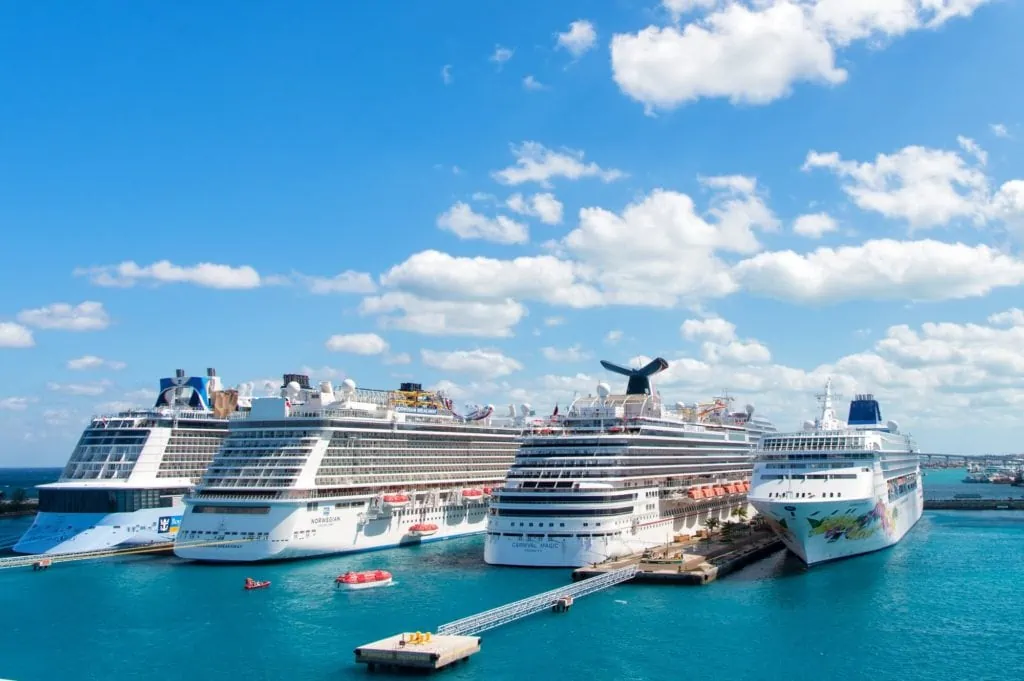
Despite innovations in engine technology, cruise ships produce a lot of pollution.
To further reduce ships’ environmental impact, many cruise ships can connect to the cruise port’s power grid , known as “shore-to-ship power” or “cold ironing.”
In the past, cruise ships kept their engines running while docked to generate electricity for shipwide services.
But most of the energy produced by the ship’s engines goes towards powering the propellers, and running the engines while docked created massive energy waste.
Some cruise ships used smaller generators to power the hotel and amusement functions. The smaller generators allow cruise ships to shut off the main engines in port, reducing pollution.
Modern cruise ships are equipped with systems to “plug in” to the local power grid. Even some older cruise ships are being retrofitted to allow for shore-to-ship power.
Not all cruise ports have facilities to enable shore-to-ship energy. But many larger cruise ports have dockside electrical hookups that allow cruise ships to shut off their engines and run on the city’s electrical grid. The technology reduces harmful emissions by up to 95% while ships are docked .
Considering how much time cruise ships spend docked at port, it significantly reduces sulfur and carbon emissions.
How Loud is the Engine Room of a Cruise Ship?

A cruise ship engine room is incredibly noisy, exceeding 173 decibels . At this noise level, the noise in an engine room can cause immediate damage to your hearing without proper ear protection.
For reference, a gunshot is 130 decibels.
Engine rooms have insulation and sound-reducing technology, so it’s not as noisy. To prevent hearing damage, crew members must wear hearing protection when entering the multi-story engine room.
But guests don’t have to be concerned about the noise.
Thanks to the insulation and sound dampening, you’ll only hear a slight “purr” if you’re near the engine room.
You may feel the engine’s vibration if your cabin is on the lower decks, near the aft . On most ships, the noise isn’t enough to cause any annoyance or trouble sleeping.
But if you’re a light sleeper, accommodations near the engine room are among the worst cabins on a cruise ship .
Where are the Fuel Tanks?
The fuel tanks are located below the passenger decks , near the engine room. The fuel is stored in double bottom tanks.
How Much Fuel Can a Cruise Ship Hold?
A large cruise ship of 1,100 feet in length can hold between 1 to 2 million gallons of fuel .
It’s enough to power the cruise ship for up to two weeks of sailing without refueling.
Are There Cabins Near the Engine Room?
Newer cruise ships have a large gap between the cruise ship engine room and passenger cabins to minimize noise and vibrations.
However, you may still find cabins reasonably close to the engine room.
If you book a cabin near the engine room, you can expect to hear some noise and feel the vibrations caused by the engines . However, cruise ships use sound-dampening technology and insulation to minimize noise pollution.
The engines are typically cheaper because most passengers avoid booking cabins next to the engine room.
Cabins near the cruise ship engine room aren’t noisy enough to cause annoyance or sleeping issues.
If anything, the vibrations caused by the engines are more likely to cause annoyance over the sound of the engine .
How Much Fuel Do Cruise Ships Use?
It takes a lot of fuel to power a cruise ship.
The average cruise ship uses around 18.3 gallons of fuel per minute or 1100 gallons per hour . ( Source )
Marcello De Lio
Trending now

- CruiseMapper
- Ships and Lines
Cruise Ship Engine Power, Propulsion, Fuel
These are some of the most interesting cruise ship technology-related data and facts - engines , power , marine propulsion systems , fuel consumption of cruise ships , and something about pollution (in-article navigation links).
In 2020, IMO (International Maritime Organization) implements its global 0,5% sulfur cap on marine fuels. If not using scrubbers (pollution control devices), owners of older vessels must use as ship fuels either MGO (marine gas oil), ECA Category Fuels (low sulfur MGO), new modified fuels and blends, LNG (liquefied natural gas) or electric/battery power . Each fuel option is based on vessel type and age, routes/itineraries and powerplant. Most newbuild passenger ships are LNG-powered . World's largest seaports plus numerous smaller ports already have installed shoreside power capabilities providing shore-to-ship power supply to berthed vessels. In many ports, shorepower is in addition to LNG bunkering capabilities.
Cruise Ship Engine
Without a source of power, these huge cruise vessels would be nothing more than drifting aimlessly hotels. A large number of older ships use diesel reciprocating engines for generating power for propulsion. Cruise ship engine power is supplied through the transmission to the propeller shafts. These transmissions determine the revolutions of propellers. Modern ships use either diesel-electric engines or gas turbines as a source of power for propulsion, and for ship's systems. Some of the larger ships depend on two power sources - one for electrical power and one for propulsion.
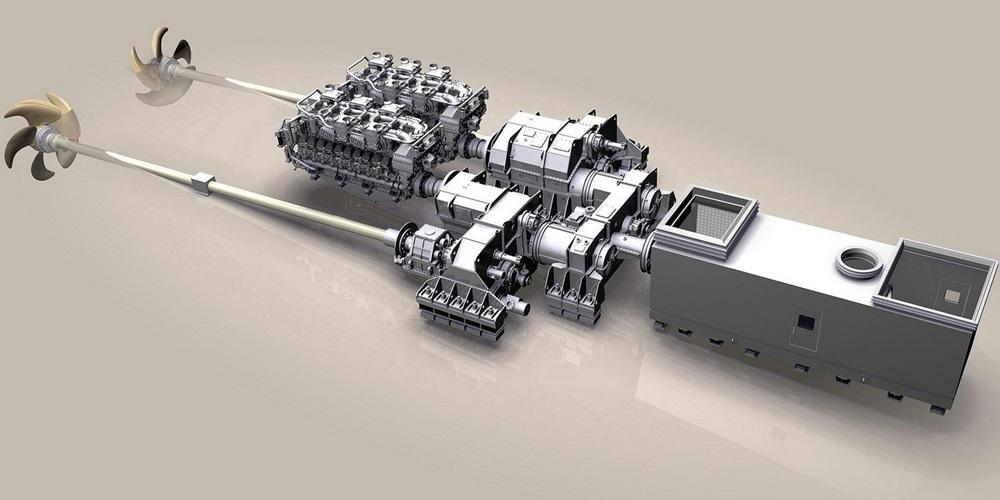
Gas turbine engines (being aero-derivative) generate heat which is transformed from mechanical energy into electricity. To achieve this, compressed air is fired in a combustion chamber. Hot exhaust is made over a turbine that spins to drive mechanically a shaft. The power can be used to spin the generators. The same way works diesel-electric engines, yet they use a direct drive system, not a turbine. The output shafts, to produce electrical power, are connected to generators.
Both engine types need a lot of fuel. Cunard QE2 , for example, consumes daily 380 tons of fuel when traveling at 29 knots speed and carries fuel enough to sail for 12 days. Usually, ships fill up at various seaports and use fueling barges as floating gas stations. Vessels use lower-grade diesel which tends not to burn as purely as diesel-powered road-going vehicles.
All ships rely on propellers/screws to be pushed through the water, providing forward and reverse motion. Airplanes, for example, require tremendous propeller speeds to provide the forward motion, but ship propellers don't need to turn so fast and rely on torque power. Therefore, ships travel slowly and rarely top 30 knots (for more info follow our speed-link above).
Cruise ship engine room
The basic detail about the cruise ship engine room is its location. For stability, the ship's heaviest weights are at its lowest possible deck, and usually, engines are mounted above the keel. Ship's lowest decks are almost entirely full of machinery. An area creating enough power for driving such an enormous vessel through water needs to be really big - very often engine rooms occupy at least three decks. Rather than long halls stretching the length of hulls, machinery is almost always divided into smaller compartments - one for the main engines, another for the heating/air-conditioning system. This compartmentalization is for safety reasons. If a penetration to the hull or fire happens, multiple compartments help contain the damage. The next photo shows the engine room of RCI's Oasis-Class vessels.
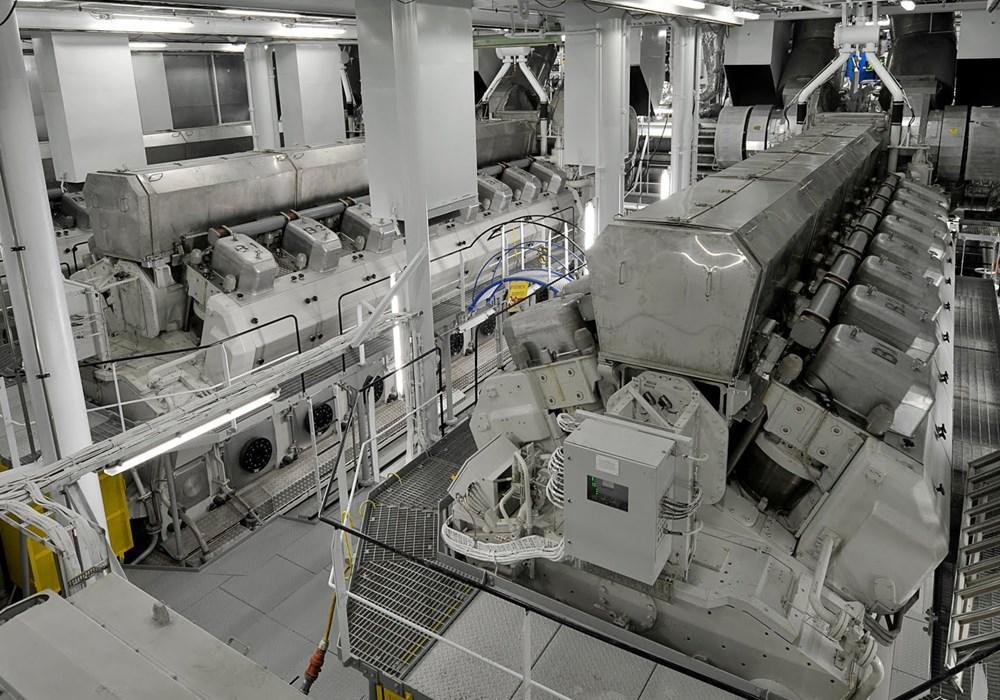
Rarely, engines are not placed at the ship's bottom. RMS Queen Mary 2's four main diesel engines are above the keel, with two smaller gas turbines on top-deck (aft of the funnel). It was not unusual for older liners to have 2 engine rooms. Gradually, technology allowed the consolidation of these spaces. However, current maritime legislation requires vessels to have equipment duplication and 2 engine rooms.
In May 2015, Wartsila Corporation and Carnival Corporation partnered to optimize cruise ship engine room operations of all 101 ships across the corporation's 9 brands. The deal was signed by Micky Arison (Carnival's Chairman) and Bjorn Rosengren (Wartsila's President and CEO). The plan included installing Wartsila's latest marine solutions, first tested on several Carnival Cruise Line vessels in pilot projects. The new systems and technologies included engine control and monitoring systems, safety and fuel efficiency equipment.
Wartsila's "Asset Performance Optimization Solution" package allows obtaining optimal performance from Wartsila marine diesel engines, recommends how to deal with potential issues, maximizes ship performance, ensures full-capacity systems operations, increases the predictability of fuel management and maintenance needs. Wartsila's fuel engine package was specifically designed to reduce fuel consumption.
Wartsila Marine technologies aim to optimize ship performance, but also allow to locate deviations from normal parameters of equipment and engines. This allows emerging problems and engine fault sources to be fixed before they occur.
Conventional diesel cruise ship engine
Today's direct-drive diesels feature one main advantage - the option to use a shaft generator, which is a device using the circular motion of the propeller shaft in order to generate the electricity needed for hotel services, like cooking and lighting.
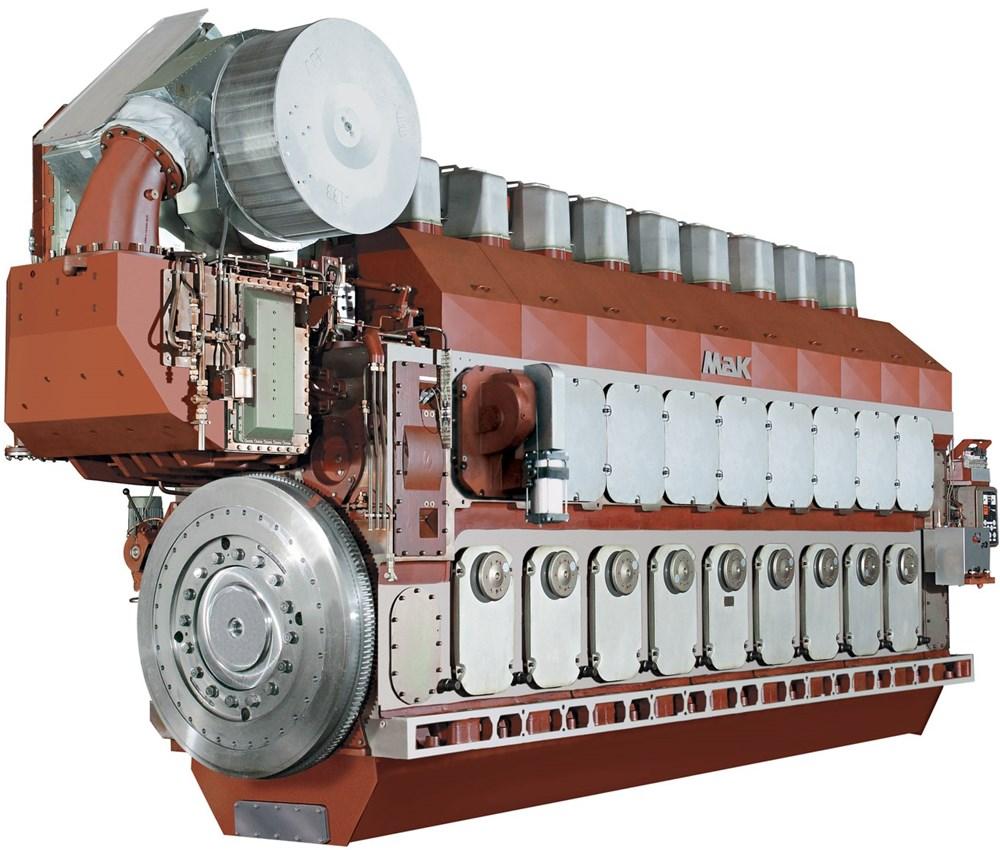
Shaft generators can be used only while the ship is moving with a fairly constant cruising speed. This is what the NCL Epic cruise ship engine looks like:
Diesel-electric cruise ship engine
Almost all new ships feature a diesel-electric propulsion form. On these ships, main engines are not connected to propeller shafts, and instead of it they are directly connected to big generators in order to produce electricity, which is sent in turn to electric motors, that then power and help turn the propellers. The main advantage of the diesel-electric cruise ship engine systems is efficiency as they allow main engines to operate near the most efficient speed, no matter if the ship is moving at 5 or 25 knots.
Losing electrical power is devastating to ships. Main engines and generators require electricity and it's needed to keep them going. Pumps that are driven electrically take in cold ocean water to cool the engines and electrical pumps get fuel from fuel tanks and supply it to the engine. Electrical power is vital for many operational functions - without it, ships come to a halt.
Large equipment (propulsion motor, bow thrusters) requires electricity of high voltage. As for smaller machinery (cabin lights, galley equipment), the electricity goes through the transformer and is thus stepped down into lower voltage. Large cables snake through all the ships to distribute electrical power. They carry power from generators to switchboards, through passageways, public rooms, crew and passenger cabins. Cabling can be a weak point in the distribution system. If the electrical cables aren't truly redundant, even ships that feature two engine rooms suffer power failure.
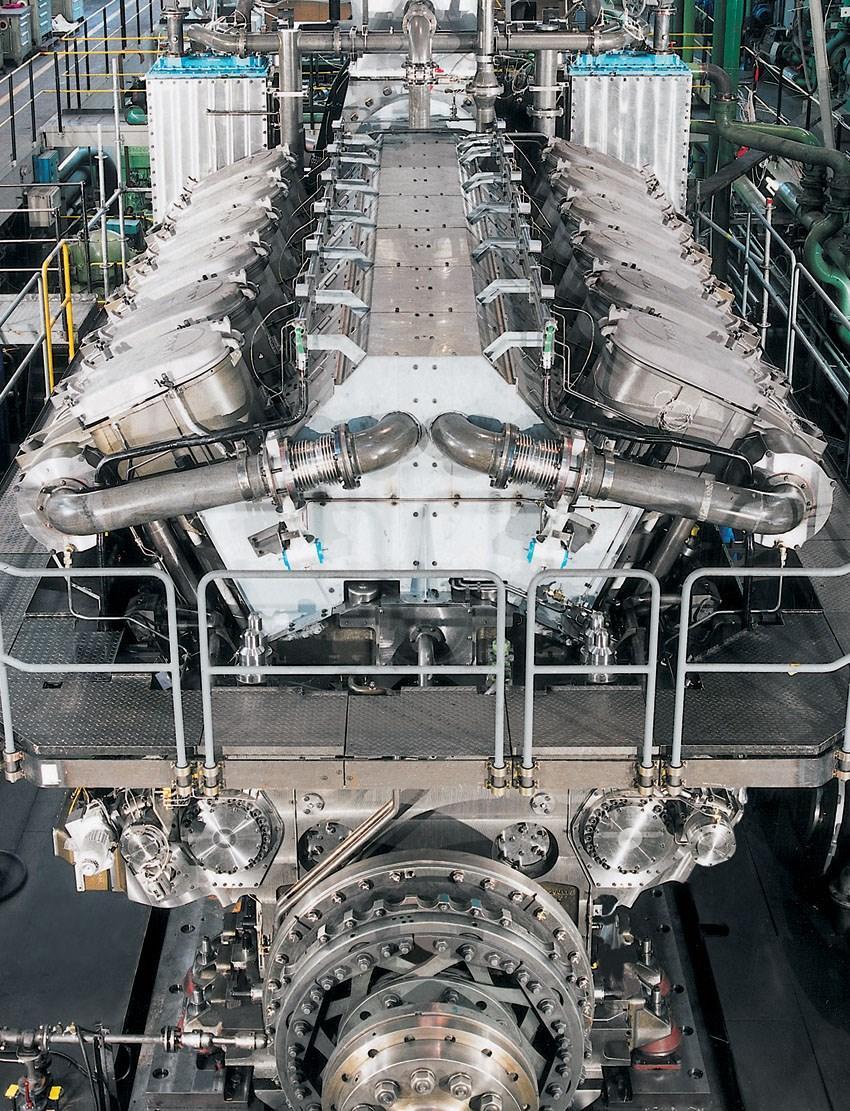
While ships are docked, generators and main engines produce more power than needed. They are turned off in port, and smaller generators supply "hotel" loads (lights, air-conditioning, galley, etc.). Moving through water takes up the vast majority of the ship's power needs - about 85% of all the diesel-electric powerplant production is consumed by the propulsion system. The above photo is of the Vista-class Carnival cruise ship engine room. The engine type is "MAN 2 times; 14V48/60CR" (common-rail diesel injection system):
Cruise ship Emergency Generators
All ships are supplied with emergency generators to maintain vital electrical power. Backup generators are located higher up and also outside engine room spaces to isolate them from damage or fire.
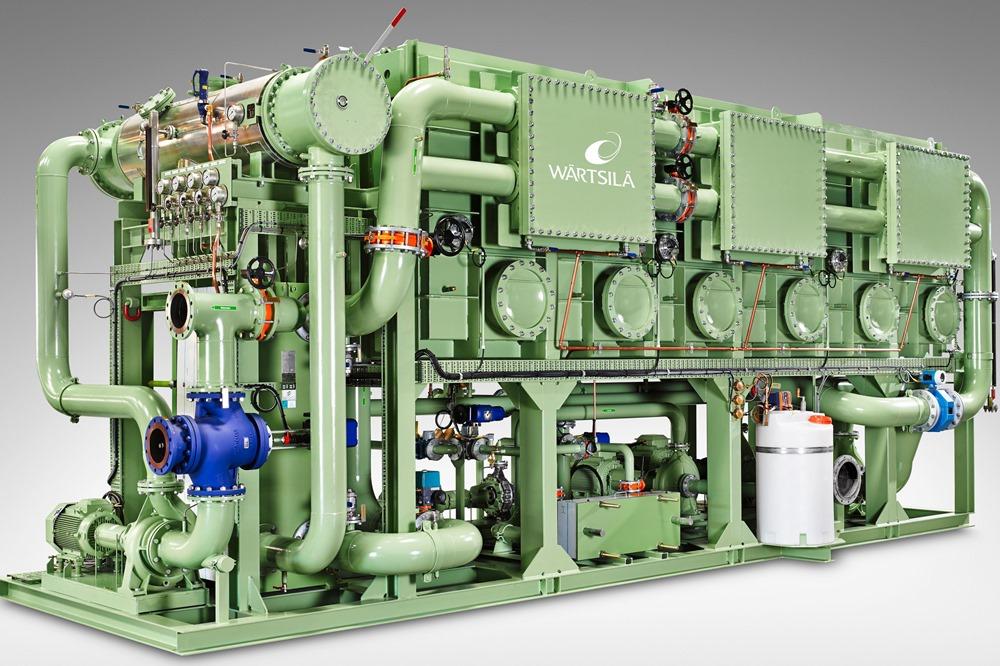
Big ships require much power, so they might have more than one emergency generator. Despite that, they don't have the capacity of main generators and engines, don't produce electricity enough to move the ship, and can't supply all the power needed in ports, because of constraints in space.
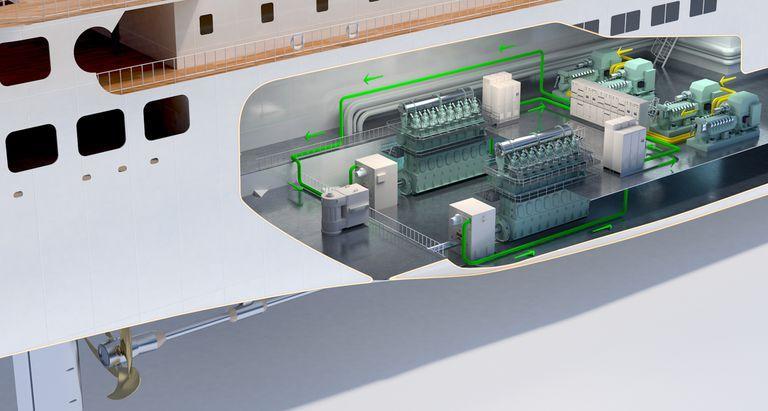
Emergency generators are instead used only for essential navigation systems - crucial communication equipment, critical pumps in the engine room, emergency lighting. Should they also fail, vessels are required to have a battery backup. 24 hours of power are at least provided by battery rooms to the smaller emergency equipment list.
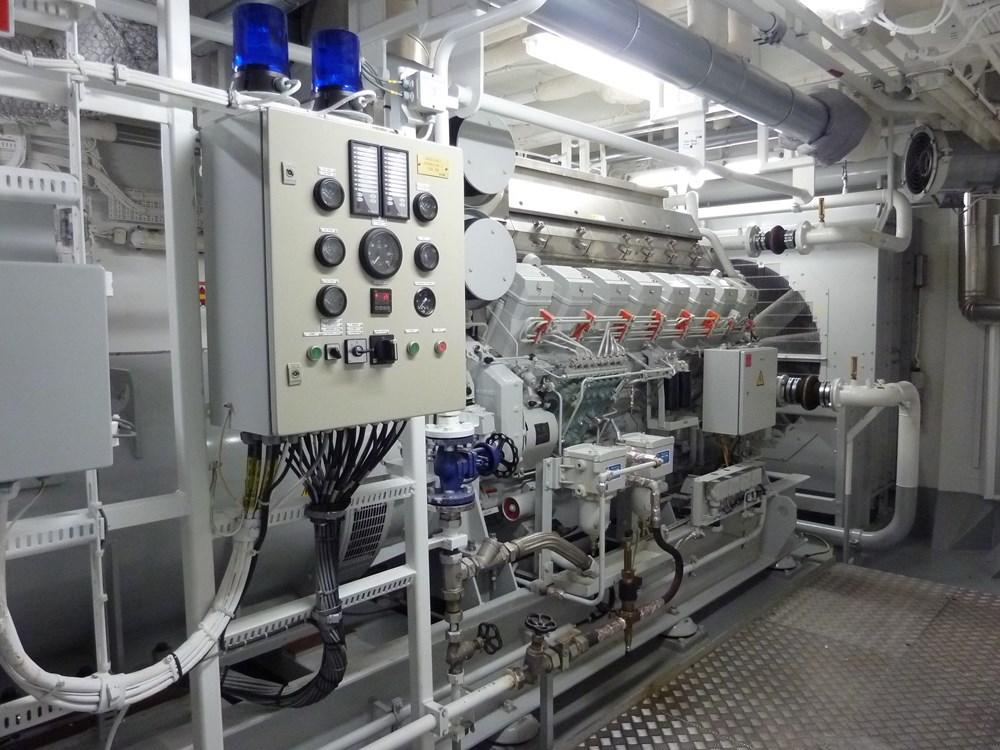
Probably you've heard about Carnival cruise ship accidents related to power failures in 2013. At our Carnival Fun Ship 2.0 upgrades link you can learn how CCL battled with this "unmaintained ships" image and implemented revolutionary new technology initiatives fleetwide - including an additional emergency backup generator on each of their vessels.
Cruise Ship Propulsion
The new cruise ship propulsion systems ABB Azipods XO (below photo) are more fuel-efficient than traditional systems, also providing better maneuverability, maximizing speed, reducing bad emissions, which as a whole optimizes ship's performance and enhances passenger safety.
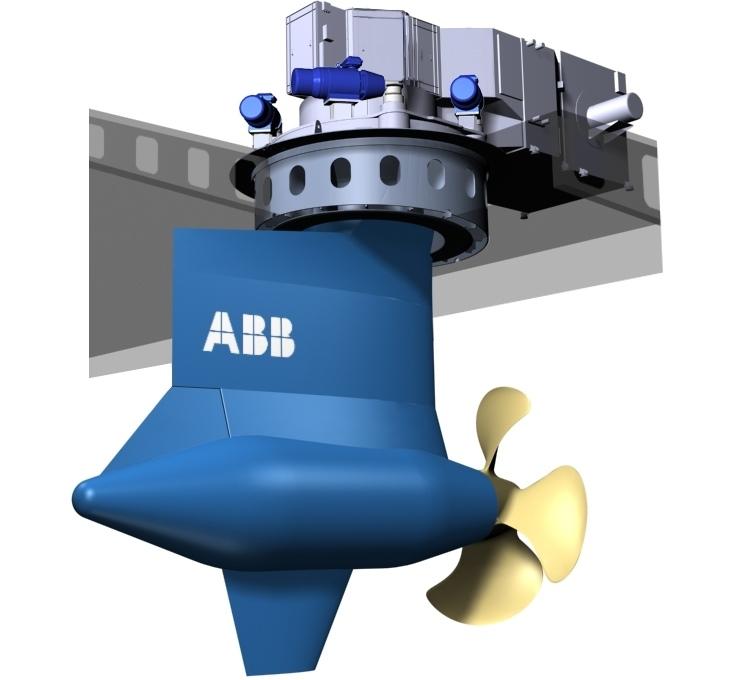
ABB Azipod propulsion systems have a major impact on the vessel's operating efficiency - reducing energy consumption and bad emissions by up to 20%.
In 2019, ABB signed a deal with Oldendorff Carriers (1921-founded, Germany's largest bulk shipping company with a fleet of ~700 ships) for the supply and installation of Azipod propulsion systems on two newbuild carriers. Both self-unloading dry bulk vessels were China-built (by Chengxi Shipyard Co Ltd / subsidiary of CSSC) and scheduled for deliveries in 2021. Each vessel was fitted with two Azipods (power output 1,9 MW per unit) plus various related electric and digital solutions (powerplant, diesel-electric generators, bow thruster motors, transformers, switchboards, power management system, ABB Ability global ABB real-time monitoring).
Azipod cruise ship propulsion system
Azipod cruise ship propulsion system is situated outside the hull in the aft of the ship. Azipod turns in all directions (360 degrees) by a rudder, providing thrust in any directions, not possible for conventional systems.
See at the first photo at right RMS Queen Mary 2 's propulsion system scheme.
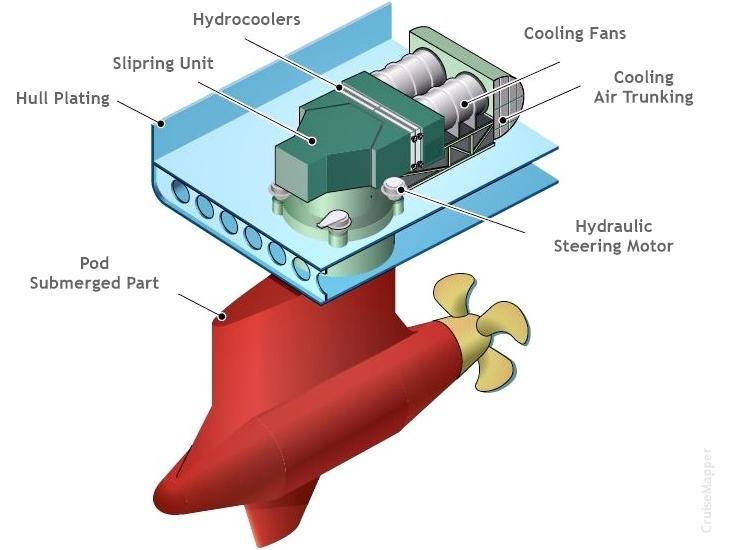
QM2's Azipod is actually an electric propulsion system consisting of the following main components:
- Propulsion motor - used to produce or drive thrust. The propeller's rotating is powered by an electric motor.
- Supply transformer - power produced by generators is 6600 KV, which is stepped down to the necessary voltage by supply transformer and is provided to the motor in the pod.
- Frequency controller - used to change the frequency of supplied power so that the rotating motor speed can be controlled.
Azipod marine ship propulsion is a combination of both steering and propulsion systems. Conventional marine propulsion systems use a two-stroke engine connected to a shaft, that passes through a stern tube and shaft tunnel to connect to the propeller outside the hull in the ship's aft/stern. This system's steering is done by a rudder (in the propeller's aft).
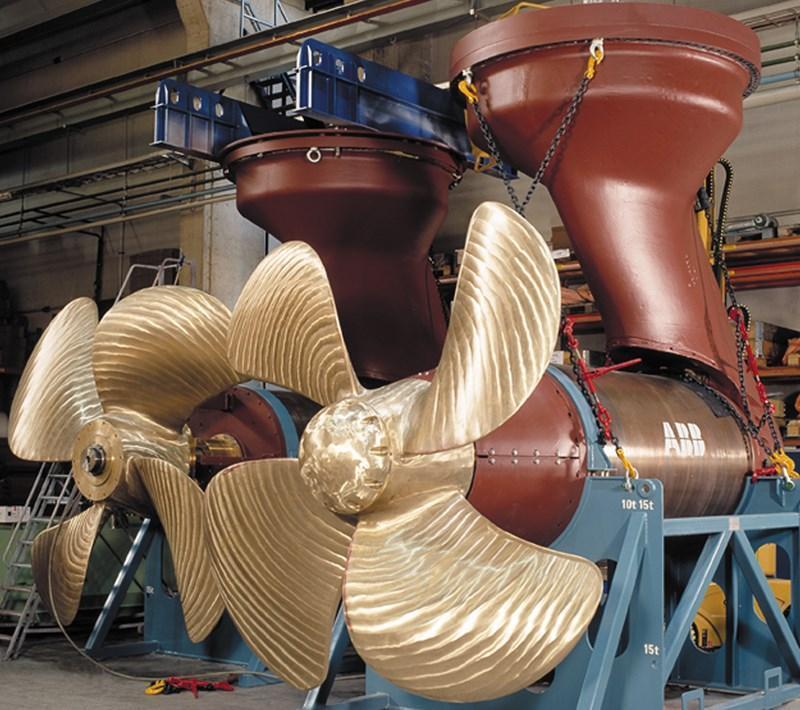
The above photo shows Oasis-class ship propulsion Azipods (2 units) before being mounted onto the hull. The next photo shows the Azipods (both units) mounted on the hull.
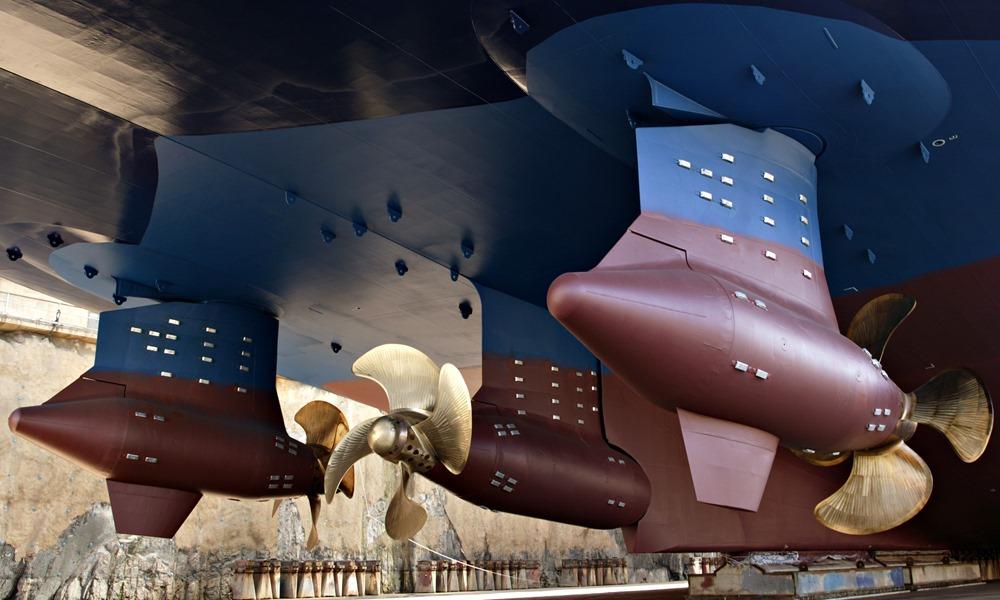
The 3rd Oasis-class ship - Harmony of the Seas, is currently the most technologically advanced and energy-efficient cruise vessel ever built. It is equipped with a new-generation exhaust gas cleaning system (multi-stream scrubbers) and also features a hull lubrication system allowing the ship to float on air bubbles (created around the hull) thus reducing drag and increasing fuel efficiency.
However, the steering and propulsion systems in Azipod arrangement, are combined into one part and the system consists of a propeller (driven by an electrical motor) turned by a rudder connected to the azipod system. The motor is inside the sealed pod and connected to the propeller.
The following YouTube video is about ABB Azipods installed on the new Genting Hong Kong vessels (Star Cruises' new ships and on Crystal Cruises' polar-class boats).
These ships incorporate a complete ABB propulsion - Azipods, electric power plant, computer automation, and software. Crystal cruise ships are powered by two "Azipod D" units allowing navigation in polar destinations. Each of the Star Cruises "Global-Class" vessels have three "Azipod XO" thrusters. All ships have installed ABB's "Intelligent Maneuvering Interface" and the "OCTOPUS" software optimizing fuel consumption and energy management. All these ships were constructed by the German shipbuilder MV Werften. Currently, almost 2/3 of all large-sized cruise vessels, icebreaking ships, and high ice-class cargo ships are with Azipod propulsion.
Advantages of Azipod propulsion marine systems
- A lot of space is saved by the Azipod cruise ship propulsion system in the engine room - there is no propeller, engine, shafting or other arrangements. This saved space can be used for storing cargo.
- Great maneuverability - the propeller can turn in all directions and enables crash maneuvering stop distance that is better than the conventional systems.
- Azipod cruise ship propulsion system can be placed below the ship's height and provide more efficiency than conventional systems.
- In case the ships have large breadth, two (or more) azipod systems, independent from one another, can be used to provide subtle maneuvering.
- Side thruster's use is eliminated as pods can be used to provide side thrust.
- Low lube oil and fuel consumption.
- Lower vibrations and noise than conventional systems.
- Because emissions are low, it's environment-friendly.
Disadvantages of the Azipod marine propulsion
- It requires great initial cost.
- Many diesel generators are needed for producing power.
- The power produced by the motor is limited - the maximum available power now is 21 MW.
- Azipod cruise ship propulsion systems can't be installed in heavy cargo ships that need large motors and a lot of power.
Royal Caribbean Quantum-class cruise ships propulsion
In April 2012 ABB made a USD 60-million contract to provide the Azipod propulsion systems for the new Royal Caribbean ships of the Quantum-class (Quantum, Anthem, Ovation) and Quantum Plus-class (Pulse, Passion). The former name of this vessel design was "Project Sunshine". Builder is Meyer Werft (Papenburg, Germany).
ABB also supplies the power generation, distribution systems, bow thrusters, and of course, the 2 x 20,500 kW propulsion Azipod XO units (at the photo at right), transformers and drives.
NCL Epic ship pod-propulsion
When entering service in 2004, the Cunard's QM2 was the biggest in the world at 150,000 GR tonnes. Her designer Stephen Payne showed the advantages of pod-propulsion giving vessels increased maneuverability. The propellers (screws) of the QM2 ship are mounted on the pods which rotate 360 degrees and provide advanced maneuverability. He made the choice to put pods - though relatively new and yet untested for big ships. Royal Caribbean vessels of Oasis, Freedom, and Voyager classes have pod-propulsion as many other big ships, which is opposed to the fixed traditional screws which push in one direction only.
An interesting fact about cruise ship propulsion is that Norwegian Epic doesn't have pods, though slightly bigger than Queen Mary 2 (at 153,000 GR tonnes), because of NCL concerns about the new technology. Some of the lines (including Celebrity and Cunard) have suffered vessel breakdowns due to pod-bearing failures. Lots of voyages had to be canceled, extensive dry-docking periods were required for pod bearings to be replaced, and NCL didn't want to take the risk.
Currently, NCL Norwegian Epic has two rudders with conventional non-Azipod screws. But how does she manage to maneuver if they can push in one direction only? One option is to make them bigger and more effective when maneuvering, another is to add additional mini-pods or install full-sized pods. Only time will tell if any of these will actually ever happen.
Rolls-Royce cruise ship propulsion system "Promas Lite"
In November 2013, the manufacturing giant Rolls-Royce upgraded Hurtigruten's ship MS Richard With its new "Promas Lite" propulsion system (integrated propeller-rudder system). This is an older ship, and Promas Lite was the perfect choice as it is a combined "propeller-rudder" system increasing the efficiency of older passenger vessels with lesser tonnage. The upgrade significantly reduced Hurtigruten's operating costs on this vessel. The improved propeller efficiency was estimated to be between 11-14% at a cruising speed of 15 knots (17 mph / 28kph).
Promas propulsion integrates propeller, hubcap, rudder bulb and the rudder into a single unit which can increase propulsion's efficiency by 3-8% (1-screw vessels) and by 2-6% (2-screw vessels). It also improves maneuverability, reduces fuel consumption and bad emissions. The new modular technology allows efficient and cost-effective custom-made systems to be built up from various existing and standard parts - mooring winches, anchor cable lifters, warping heads.
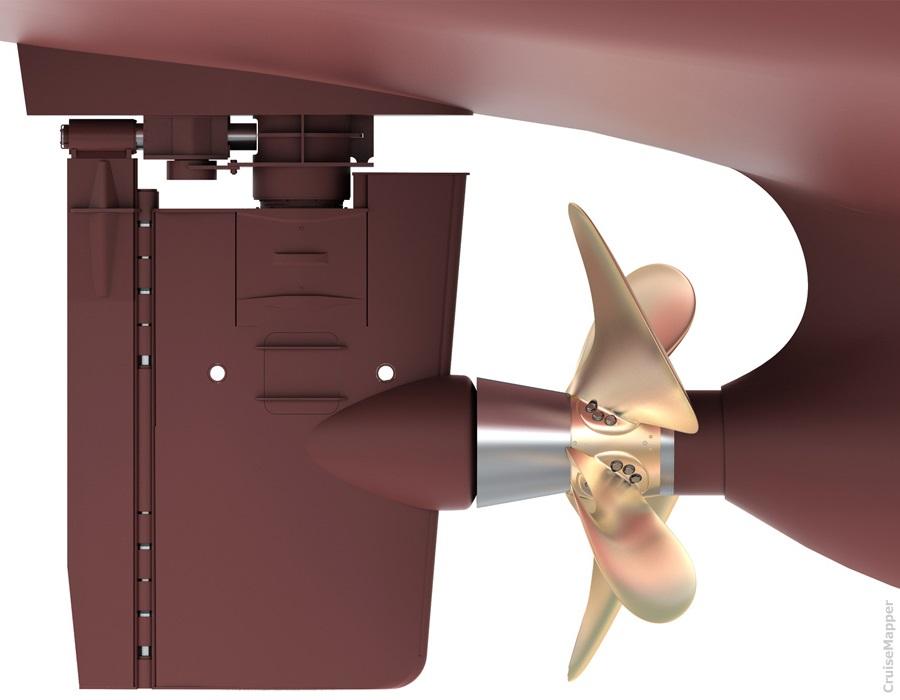
Hurtigruten was compensated with ~80% of its total investment in Promas Lite marine propulsion upgrades as the Norwegian Government has this NOx fund encouraging shipowners and operators to upgrade their vessels and invest in new marine technologies that reduce NOx emissions. The Promas Lite propulsion future clients, besides passenger ships, are marine vessels like fishing and freighter ships.
After Norwegian Spirit (the first ship in NCL fleet with installed Promas Lite in 2011), in May 2014 the Star Cruises ship SuperStar Virgo became Southeast Asia's first passenger liner with RR's Promas Lite propulsion. Fincantieri used Promas Lite propulsion for all Viking Ocean liners.
Cruise Ship Power
The cruise ship engine power is responsible for driving propellers, and the other possibility is producing electricity that is used subsequently to drive propellers. The engine's effectiveness depends not only on the design but also the ship's shape, weight, and size. Power is measured in horsepower traditionally - one horsepower equals 746 watts. The next photo shows the world's largest passenger ships' engine that powers each of the Royal Caribbean Oasis-class vessels.
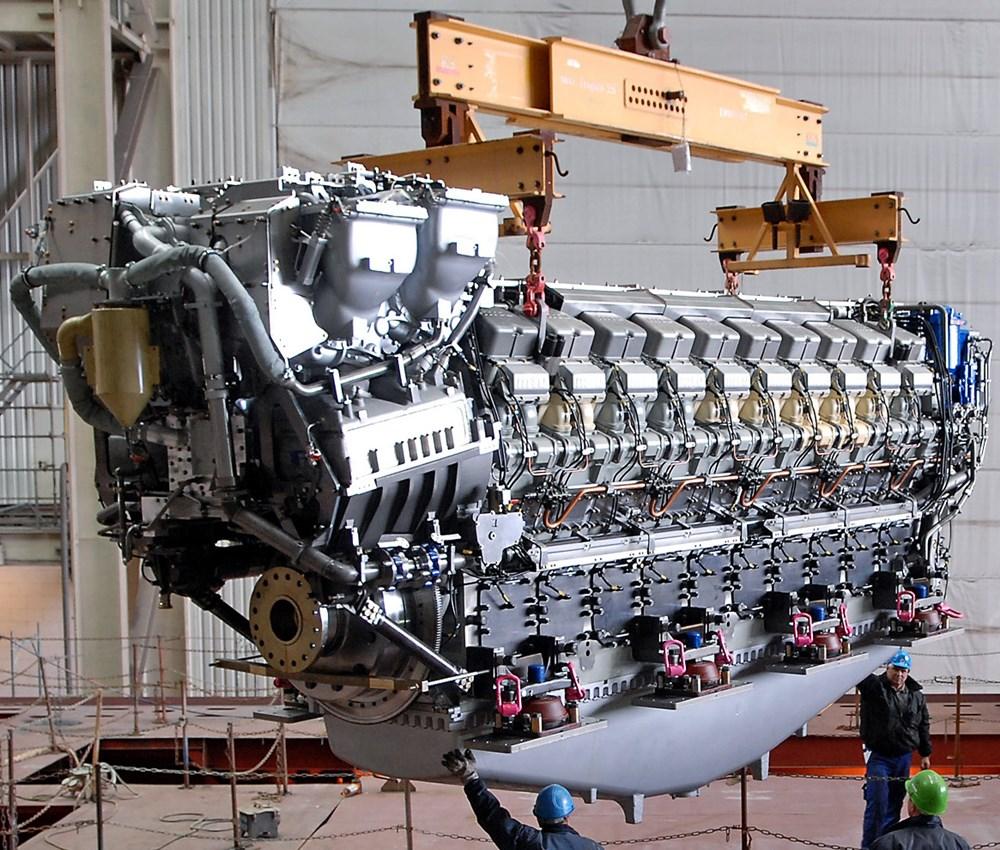
Marine steam engines
The cruise industry began in 1844, when ships were propelled by steam engines, performing the driving of propellers by using steam as working fluid. The largest passenger steamship (before hitting an iceberg on April 14, 1912) was the Titanic, powered by both reciprocating engines and turbines, able to generate 50,000 horsepower (37 megawatts).
Marine diesel engines
Usually, ships are powered by four or five generator sets (medium-speed, 500 revolutions per minute), fueled by diesel and creating 8-10 MW energy each. The power density of marine diesel medium-speed engine is 80 kilowatts per cubic meter. Ships that use diesel engines are required to carry exhaust-treatment systems and catalytic-reduction equipment to reduce the environmental impact.
Marine nuclear power engines
The building of the US first and only merchant nuclear-powered ship was commissioned in the 1950s by President Eisenhower. Of total cost $46.9 million, on the fuel core and nuclear reactor was spent more than $28 million. The ship operated only for five years (1965-1970) but due to the high running costs, its service was terminated.
Marine gas turbines
The first company that fitted cruise vessels with gas turbines, was Royal Caribbean. Gas turbines are greener than diesel engines and allow ships to sail with reduced inventory and smaller maintenance crew. Gas turbines drive generators which in turn provide electricity to propeller motors. They recover heat from gas turbines' exhaust, which then is used to produce the electricity needed for onboard services (air conditioning, water heating).
Rolls Royce is the manufacturer of the world's largest GAS marine turbine "Rolls-Royce MT30". The turbine will provide the immense 109 MW of power for the 2 propellers, all the weaponry, radars, command sys, etc. of the new generation UK aircraft carriers of the Queen Elizabeth class. To this class belong HMS Queen Elizabeth (2017-commissioned) and HMS Prince of Wales (2019-commissioned), each of them with a total power consumption of 80 MW.
Gas-turbine cruise ship power system
The first large vessel to use a new gas-turbine cruise ship propulsion system was Celebrity Millennium . This system will be more frequently used in new cruise ship buildings . It's innovative and, besides new activities available, the economy of scale, marketing, represents an important element of ship design. System's advantages include:
- lower vibrations and noise level, better comfort, lower probability of failure;
- lower exploitation costs because of the easier maintenance;
- nocive emissions reduction, which is partially owed to gas oil instead of fuel (-90% oxide of sulfur, -80% oxide of azote).
- considerable gain of weight and volume, especially when with Azipod marine propulsion system (900 tons, 70 cabins added).
Gas turbines at this time are only interesting in the building of high-speed ships (warships, and especially aircraft carriers, or fast passenger vessels - Millennium max speed is 25kn), because of the better diesel output in lower speeds and higher price of gasoil instead of fuel for diesel engines.
Gas turbine cruise ship propulsion systems are able to avoid pre-heating systems needed for fuel in classic installations (risk of fire!), as they use gasoil, Celebrity's Millenium-class and RCI's Radiance-class use such turbine powerplants. The next photo shows Celebrity's Solstice-class ship propulsion (the 4 aft azipods, and the underwater hull shape).
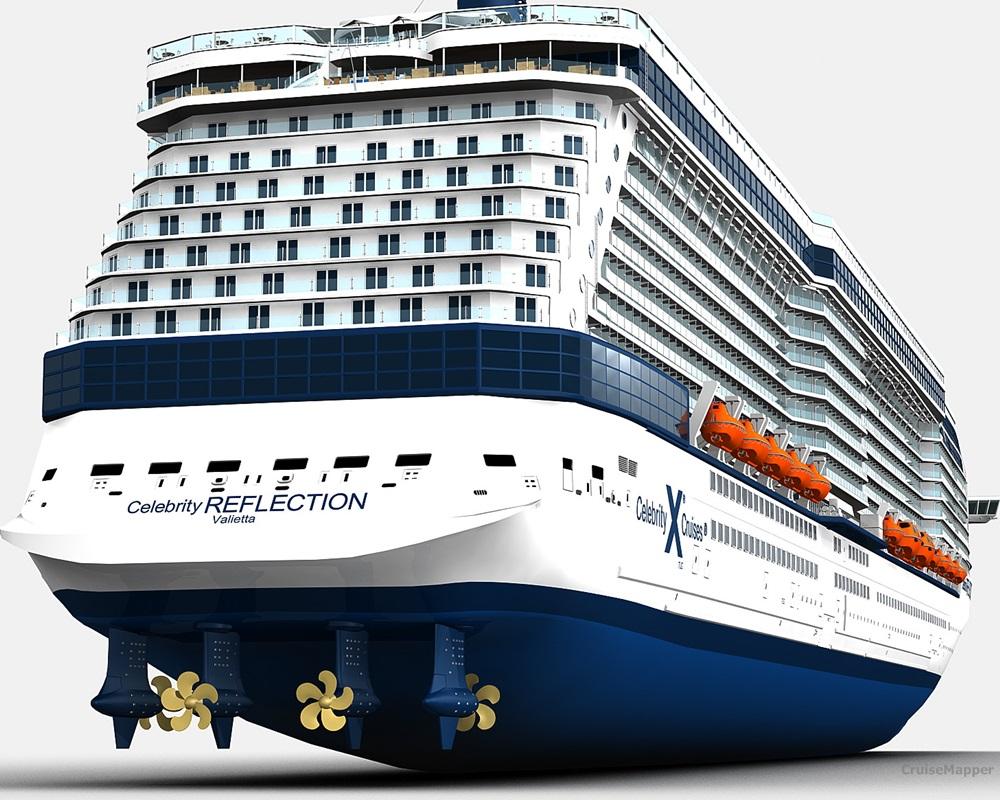
LNG-powered cruise ships
In June 2015, Carnival Corporation announced the company's contract with Fincantieri to build four LNG-powered vessels with the industry's largest passenger capacity. This was part of the order with Meyer Werft and Fincantieri for a total of 9x units to be built in the period 2019-2022.
The four newbuilds became the industry's first LNG (Liquefied Natural Gas) powered vessels using LNG in their hybrid engines. The gas is stored in the ship and used to generate all needed power at sea. The engines are not exclusively LNG, but "dual fuel" (capable of burring both liquid marine fuel and natural gas). This design is for saving onboard space (reducing fuel storage space required).
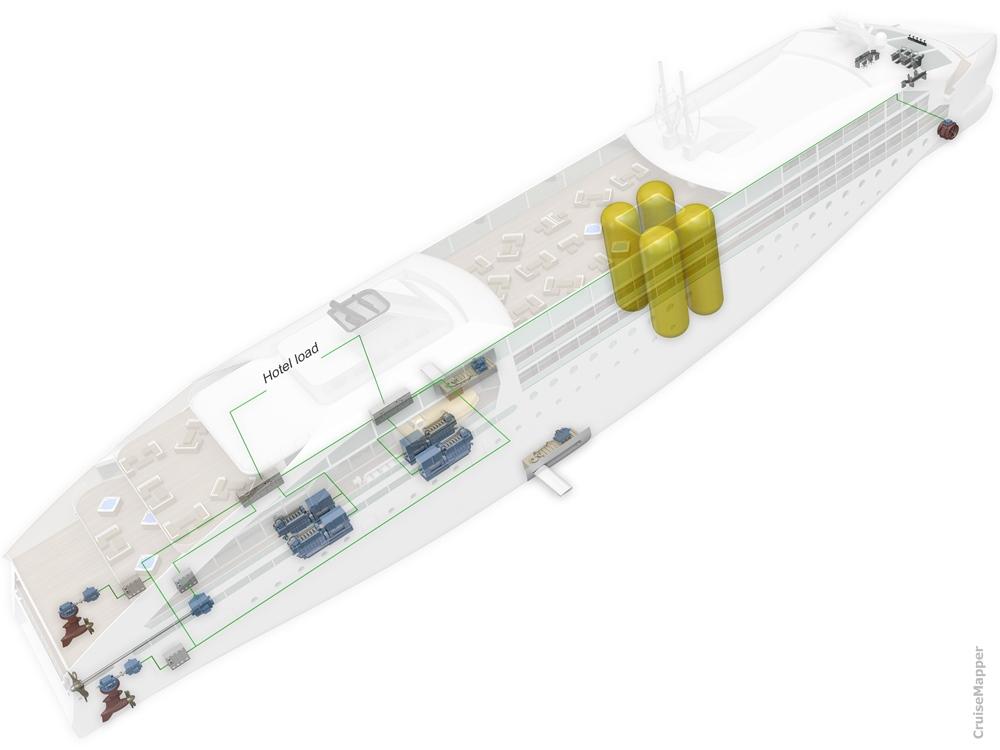
LNG is natural gas, which consists of 90% methane and 10% ethane. When cooled to -160 C, it passes from gas to liquid, and its volume decreases over 600 times, making it very efficient for distribution. Long-distance LNG transportation is via dual-hull gas carriers. Short-distance LNG transportation is via trucks or smaller vessels (also barges) fitted with high-pressure tanks.
Gas fuel eliminates all the bad emissions - soot and sulfur oxides. In April 2016 MSC Cruises announced its contract with STX France for up to four LNG-powered ships with GT over 200,000 tons each. For comparison, the Oasis of the Seas is 225,000 GT tons. The new MSC ships have 5400 passengers capacity at double occupancy each. The first one is scheduled for delivery in 2022. Its power plant will be based on a new prototype engine.
Using LNG to power large cruise ships is a relatively new (2016) concept. Due to LNG tanks' large sizes, this fuel is used usually on smaller passenger shipping vessels ( ferries ) operating on short crossing itineraries. LNG bunkering facilities available in ports are very few. Compared to other fuels (including MGO / marine gas oil), LNG is purer (no unburned residues, fewer greenhouse gases), more efficient, stable and cheaper (reduces fuel costs). LNG technology also advances due to IMO's future maritime emissions regulations, especially in ports and while operating in environmentally sensitive destinations.
In comparison to pipeline gas, LNG is superior in quality - purer, with more methane and other energy content. Its chemical structure also has a stable composition that doesn't generate unburned residues, soot or any particulates. In addition, because the fuel is so clean, on LNG-powered ships maintenance intervals are doubled (over 25,000 hours / ~10140 days), as opposed to the standard MDO-powered 12,500 hours (520 days).
- All the world's major environmental organizations and the marine shipping industry joined for an explicit prohibition on the carriage of non-compliant fuels when the 0,5% sulfur cap takes effect in 2020.
- In January 2018, IMO announced that starting January 1, 2020, the marine fuels' max allowed sulfur content (outside Emission Control Areas) is reduced from the previous 3,5% to 0,5%. Unless marine vessels are using approved equivalent compliance methods, after Jan 2020 there is no reason for ships to use non-compliant diesel fuels.
- IMO's new sulfur cap's goal is to provide substantial health benefits by reducing marine fuels' sulfur content (SOx gases). At the same time, IMO's lowered cap significantly increases ships' operating costs.
The LNG cruise ship concept was first introduced by Wartsila (Finnish manufacturing company) and is based on drive shaft propulsion instead of azipods. The LNG tanks' location is in the upper deck area (right below the funnels). The Rolls Royce concept is based on azipods.
AIDAprima (2016) is one of the world's most technologically advanced cruise vessels. The ship rides on a cushion of air, thus reducing frictions and fuel consumption, The new technology is called MALS ("Mitsubishi Air Lubrication System"), allowing the liner to glide on an air bubbles carpet.
The ship's 4 main engines are dual-fuel (heavy oil and LNG gas oil) thus reducing fuel consumption. The ship has an advanced filtering system that reduces stack emissions (greenhouse gases). The ship's propulsion features 1 pair of stabilizers and 2x ABB-pod drives (new XO-Pod series, power output per unit: is 3 MW). The total power output is 48 MW. AIDAprima is also the world's first-ever "LNG cruise ship" as it uses LNG fuel supply while berthed in ports.
For its LNG-bunkering operations in Florida (at homeports PortMiami and Port Canaveral ), CCL-Carnival partnered with Royal Dutch Shell plc as fuel supplier for the liners Mardi Gras (2021) and Celebration (2022).
AIDA's LNG-powered cruise ships
The AIDAprima ship's first successful test run for LNG supply was in Hamburg Germany on May 7, 2016. While berthed, the ship was successfully provided with LNG at all the itinerary's ports of call (Hamburg, Rotterdam, Le Havre, Southampton, Zeebrugge).
- The company's statistics show that the AIDA ship spends about 40% of its operating time in ports. Compared to using conventional marine diesel (0,1% sulfur content), by using LNG, the vessel's emissions were considerably reduced even further. Sulfur oxides and soot particles were prevented completely (while in port), nitrogen oxide emission was reduced by up to 80%, CO2 emissions were lowered by 20%.
- AIDA ships (produced by Shipyard Papenburg ) are 100% LNG-powered. AIDA invested in research and testing of LNG cruise ship technologies since 2015. In 2013, AIDA collaborated on LNG hybrid barges with Becker Marine Systems. The innovative and flexible solution is used on ships moored in Port Hamburg.
- Since May 30, 2015, AIDAsol is regularly supplied with low-emission LNG power at Hamburg's Hafencity Cruise Terminal.
- AIDA ships use just 3 liters (0,8 US gallons) of fuel on average per person on board for a 100 km (62 ml) trip. This was confirmed by an independent expert study in 2012. Following the implementation of new technologies and economical handling of resources, the company's statistics for 2016 (over 2012) showed reduced energy consumption (9% per person onboard), reduced water consumption (7,2% pp) and reduced CO2 emissions (7,7% pp).
Hurtigruten ships
In April 2018, the Norwegian cruise and ferry company Hurtigruten announced a USD 150 million fleet renovation project. Almost all vessels will be upgraded with new hybrid powerplants that combine LNG-engines and batteries.
For the project was contracted Rolls-Royce Marine, initially for 6 ships plus optional another 3. The program's completion was scheduled before January 1, 2021. The project also includes all vessels to be upgraded with shore power capabilities.
Dual-engine ferries (LNG-MDO)
The next scheme shows the dual-engine powerplant (Wartsila) and propulsion (Azipod) of the cruise ferry Tallink Megastar . This ship is the biggest "floating superstore" on the Baltic Sea, featuring a 2-deck retail shopping complex and the unique self-service option called "Q-shopping". The RoPax vessel uses LNG as prime fuel and MDO (marine diesel oil) as secondary fuel.
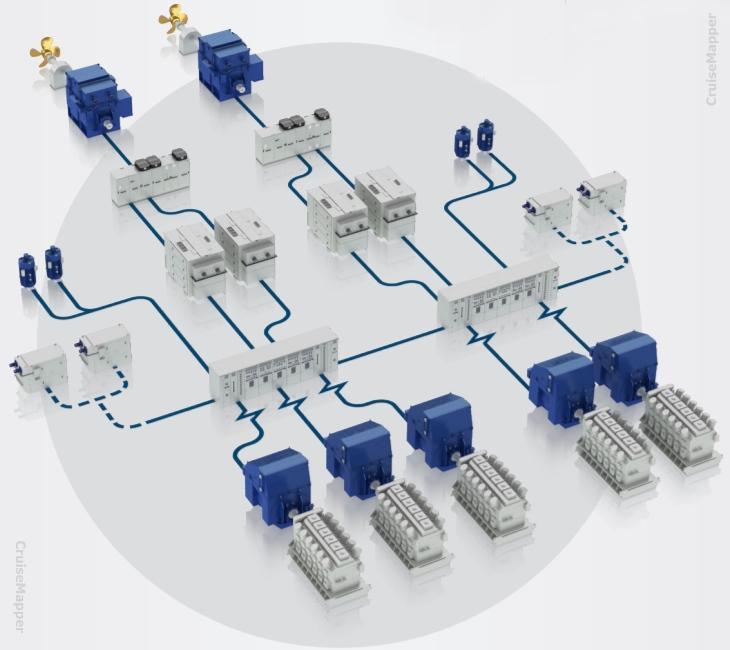
The ship is powered by a total of five Wartsila dual-fuel engines - three 12-cylinder (model 12V50DF, combined output 34,2 MW) plus two 6-cylinder (model 6L50DF, combined output 11,4 MW). Ferryboat's total power output is 45,6 MW. Its propulsion system includes two Wartsila fixed-pitch propellers with twin propeller shafts. Navigation systems are also Wartsila-made, including NACOS Platinum (integrated vessel control system).
The power generated by the main engines/powerplant produces electricity that is used from the propulsion motors, as well as all auxiliary systems and hotel functions. This innovative maritime technology allows the engines to be started and stopped depending on the onboard electricity demand, which additionally improves fuel efficiency.
Vessel's hull is ice-strengthened (class 1A). Rudders are from Becker Marine Systems. When compared to traditional marine engines, in gas mode, the ship's engines produce 1/4 less COx, 2/3 less NOx, zero SOx and no soot particles.
The onboard LNG system consists of 2 bunker stations, 2 horizontal LNG storage tanks by Linde (cryogenic, vacuum-insulated, stainless steel, total gas volume 600 m3), double-walled bunkering lines, pipelines (acid-proof stainless steel), special pipe fittings, gas distribution system, steam boilers. All the ship's electrical equipment is certified "explosion-proof". The LNG is stored at temperatures -160 Celsius (-256 Fahrenheit) and under pressure 4-6 bars.
ABB supplied the vessel's power and electric propulsion systems, as well as the Octopus (smart energy management system). While mechanical propulsion is optimized for a single-speed, electric propulsion is based on rotating speed control resulting in energy efficiency at all speeds. ABB's propulsion also improves passenger comfort as the ship runs much more quietly and smoothly. ABB's Octopus marine technology allows real-time monitoring of the vessel's energy (and fuel) consumption. Based on the collected data, the software suggests optimal performance recommendations.
Spain's first LNG-powered cruiseferry was Hypatia de Alejandria (2019) owned by BALEARIA .
Wind-assisted propulsion
On April 12, 2018, the VIKING LINE -owned ferry Viking Grace became the world's first-ever passenger ship equipped with a rotor sail utilizing wind power. This also made it the world's first hybrid vessel that uses both wind power and dual-fuel (diesel-gas) engines.
"Rotor Sail Solution" is an innovative technology developed by the company Norsepower Ltd (Finland) in 5 years. It reduces fuel consumption and also COx emissions up to 900 tons per year (depending on wind conditions).
The cylindrical rotor sail has a height of 24 m (79 ft) and a diameter of 4 m (13 ft). The technology is based on the "Flettner rotor" (patented by Anton Flettner in 1922) and uses the so-called "Magnus effect" - the spinning rotor (rotating cylinder) drags airflow faster around one side. This creates pressure/speed difference that moves it in the direction of the opposite (lower-pressure) side, creating a force at a right angle to the direction of the wind. This wind-assisted propulsion power drives the ship forward. Unlike traditional cloth sails, the rotor needs no furling (stowing), reefing (reducing sail's area) or line-tending. The rotor sail system is automated and shuts down when unfavorable changes in wind force or direction occur.
Added to the dual-fuel engines, the new technology makes Viking Grace one of the world's most environmentally-friendly passenger ships, operating with very low levels of emissions and noise. Norsepower's wind propulsion system was also installed on VIKING LINE's newest vessel (still unnamed) scheduled for delivery in 2020. The China-built ferryboat is equipped with two Norsepower-produced rotor sails, doubling its wind power potential.
Ship's powerplant includes 4x Wartsila engines (model 8L50DF, total power output 30,4 MW). Propulsion is diesel-electric (2x shafts with fixed-pitch propellers) and wind-assisted (with 1x rotor sail). Engines are dual-fuel (MDO-LNG). As gas tanks are larger than marine fuel tanks. they need 6 times more space. To save hull space, LNG tanks are located on an open deck. LNG tanks are two (type C / vacuum insulated), each with capacity 200 m3 and weight 140 tons (LNG weight 85 tons per tank).
MS Viking Grace is also the world's first ship with the energy recycling system "Ocean Marine" (developed by Climeon AB / Stockholm-based company). The system converts the excess heat (generated by engines and exhausts) into clean (emission-free) electricity with an annual capacity of 700,000 kWh. This electricity is primarily used on cabin decks (including for heating, hot water, lighting). The technology uses heat exchangers that evaporate a carrier fluid circulating in a closed system. This gas (at 2-bar pressure) drives a turbine, then a 100 kW generator produces electricity. After that, the gas is cooled (in a vacuum chamber) and liquefied. Cooling is rapid, as the cold fluid is sprayed out. Then Heat exchangers cool the carrier fluid to temperatures around 20 C / 68 F.
Cruise Ship Fuel Consumption
How much fuel do cruise ships use.
Cruise ship fuel consumption depends on the ship's size. For most vessels, the average consumption is 30-50 miles on a fuel gallon. This will be also determined by other factors using fuel. Ships' gas mileage varies depending on the type and size of ship, the number of passengers on board, and other factors. Larger ships need more fuel to move through the water.
RMS Queen Mary uses 6 tons of marine fuel per hour. Celebrity Eclipse gets 56 feet to the gallon. MS Zuiderdam - .0130 miles per gallon (0.34 tons fuel per mile). This may not seem very good mileage at first glance, however, cruise ships are moving at once thousands of people whereas a car is moving a few.
Nearly all contemporary cruise ships are powered by electricity (motors turn propellers). It powers the air conditioning systems, lights and all other appliances aboard the ship. Most vessels produce the electricity they need by using diesel engines. Some use gas turbine engines. Others use a combination of the two. HFO (heavy fuel oil) is used by diesel engines, while MGO (marine gas oil) is used by gas turbine engines. The MGO is similar to the jet airplanes' fuel.
Speed affects cruise ship fuel consumption because to go faster, vessels must increase the electricity flow to motors. Thus more engines are employed, and it, in turn, increases fuel consumption. For example, Queen Mary 2 consumes 237 tons MGO and 261 tons HFO a day when at full speed. After a certain point, the rate of return decreases from adding engines, because if a ship can manage 17 knots by two engines, it doesn't mean that four engines are going to produce 34 knots.
Cruise companies employ new technologies in order to reduce fuel consumption. Ship's hull, for example, can be applied by silicon coating in order to reduce friction as the ship goes through the water. Friction reduction on Celebrity Eclipse is 5%. Another experiment is LED lighting, using less energy and producing less heat (thus is reduced the demand for electricity and air conditioning). Celebrity Solstice-class vessels have solar panels' field over the AquaSpa pool area. This not only provides shade for the pool area but produced by solar panels electricity is used to decrease the electricity demand from the engines.
RMS Queen Mary 2 is equipped with exhaust gas economizers, using waste heat from engines to produce steam. Then steam is used to heat fuel and QM2 hotel accommodations, laundry, galleys. This reduces the energy amount that has to be produced by ship's engines. The Promas Lite system (mentioned above) generates cruise ship fuel savings in the range of 5-15% depending on the operation type and the actual performance of the ship's existing propeller.
How marine ships fuel consumption increases at higher speeds? Next infographic shows the speed-fuel consumption relation on container ships (their sizes are measured in TEU-containers/20 ft equivalent units), which are similar by speeds and even gross tonnage to cruise passenger ships.
Cruise Ship Pollution
Today cruising is one of the most popular vacations, but there are significant environmental downsides. Mega-ships burn the dirtiest fuel in the world, even if they are sitting in port. Asthma, cancer, respiratory illness, heart disease, are the results of burned in ports nasty bunker fuel.
Shore-to-Ship Power Supply
Those who support the cruise industry point out that cruising has never been more popular. However, more ships generate more pollution. A solution is to have docked vessels plug into the port's shore power grid. Most of the world's largest cruise ports have such dockside electrical hookups, reducing bad emissions by up to 95%.
Aka "cold ironing" and "shore-to-ship power", shore power capability allows berthed cruise ships to shut down their diesel engines (main and auxiliary) and plug into city's electrical grid, using locally-produced electricity for all shipboard equipment and services - including cooling, heating, lighting, emergency, etc. The technology greatly reduces exhaust emissions in seaports. Next video animation reviews this technology.

TUI Cruises Ships Environmental Report
TUI published the company's environmental impact report (first of its kind) including environmental objectives and TUI strategy for a 5-years period. TUI said it planned to issue reports every 2 years. According to it, in 2012 TUI reduced by 3.7% per nautical mile its fuel consumption, and expects further 5% reduction, reducing CO2 emission at the same time by 0.5 kg to 0.55 kg per traveler.
Energy efficiencies are the key to reduce fuel consumption, CO2, and other emissions, and contribute to climate protection. Mein Schiff 3, for example, is expected to feature special energy management systems that help to consume 30% less energy than comparable size ships. TUI is focused on reducing recycling and waste, too. In 2012, TUI reduced the waste amount to 10,7 L (per passenger day), which is 27,8% less (over 2011). In 2012, TUI used 54,463 tons of fuel, including 9,732 tons LSFO (low sulfur fuel oil), 40,880 tons HFO (heavy fuel oil) and 3,851 tons MDO (marine diesel oil). Fuel consumption was 0,367 tons per nautical mile.
All new TUI ships are built to the latest standards with environmentally-friendly marine technologies. These vessels, both as design (hull and superstructure) and implemented technologies, are highly energy-efficient. Each consumes 1/3 less energy compared to most cruise liners. The advanced exhaust cleaning system uses a catalytic and scrubber converter. This technology allows sulfur emissions to be reduced by 99%, and NOx emissions - by 75%.
All-electric passenger ships
In May 2019, the US company "Maid of the Mist" ordered ABB two new all-electric vessels for the company's Niagara Falls tours. Both catamarans are 100% emission-free being powered by high-capacity batteries. Each ship is fitted with two battery packs (combined capacity 316 kWh / 563 HP output). The electricity is provided by 2 fully-independent power systems and split evenly between the 2 hulls.
Shoreside battery charging takes just 7 min (per ship). The powerplant is controlled by ABB's PEMS (Power and Energy Management System), which also optimizes the onboard energy use. Ships' batteries are charged using hydropower (water-generated electricity), which as of 2019 accounts for ~7% of the USA's total electricity production. In addition to the shoreside charging connection, ABB supplied the newbuilds with switchboards, motors, integrated control systems and ABB Ability's Marine Remote Diagnostic System (24-hour equipment monitoring and predictive maintenance).
Battery power is used during turnaround navigation in ports when the onboard diesel-electric generators are switched off. For ferry batteries (fabrication, delivery, and installation) is often contracted the Canadian company Corvus Energy (Richmond BC) - one of the world's largest manufacturers and suppliers of energy storage solutions (ESS) for the maritime industry. The company provides ESS to hybrid and all-electric ferries. As of 2019, Corvus Energy delivered its innovative product line "Orca ESS" to 200+ vessel conversion/upgrade projects, totaling 200+ MWh.
At the following tag-link can be found listed all CruiseMapper's news related to propulsion-power accidents .
This cruise vessel technology-related survey is integrated with our articles on passenger ships building and safety , and the statistical ones about registry/flag-states , cost to build , speed , passenger capacity . All ship links redirect to the vessel's "itinerary-schedule-current position" page.

The Shipyard
For Those Who Love Ships
- Cruise Ships
How Cruise Ships Work (Part 3): The Bridge and the Engine Room
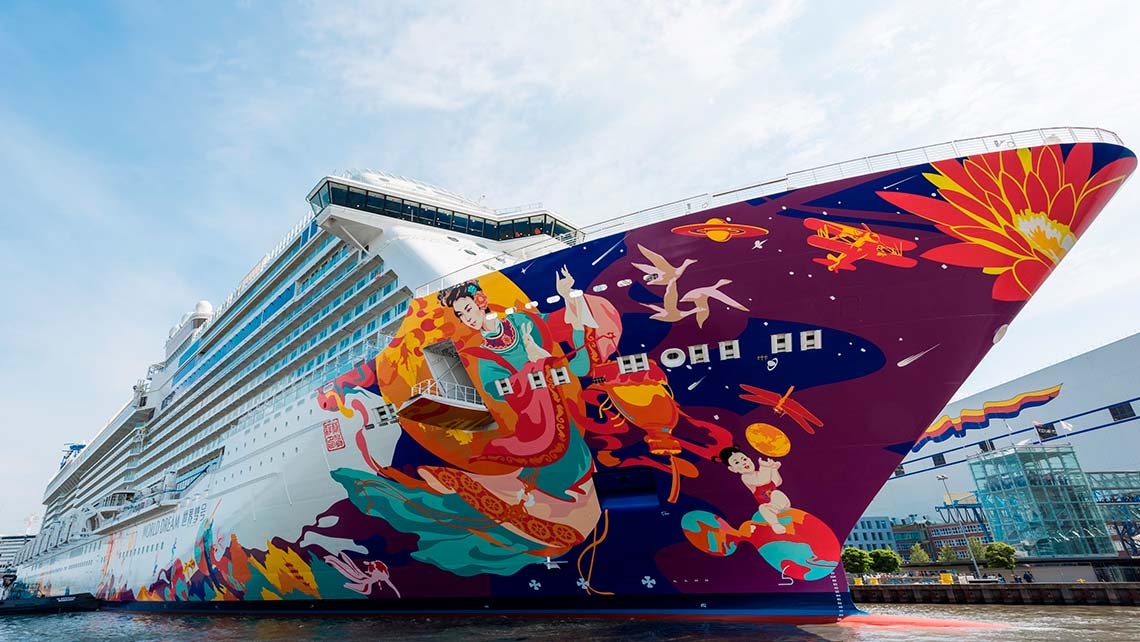
It’s like back in the days when we were little children. Grandpaw’s almost mystical tool shed was strictly off limits, but we were just dying to have a peek, weren’t we? Now that we are all grown up, Grandpaw’s gadgets are old news, but there is still a place or two on a cruise ship that remains like a pie in the sky for all of us obsessed by ships.
It’s the heart of the matter, it’s where it all happens, it’s the real deal. And if you are anything like me, you would gladly give away a day at the spa, a dessert buffet and even two, or the latest Marvel flick in the movie theater, just to spend a precious hour down in the noisy engine room of your favorite cruise ship. But life being proverbially unfair, modern cruise lines rarely allow their passengers to enter the bridge or the engine rooms of their ships, unless the visit is part of a specially organized guided tour. Some cruise ships have a window from which passengers can observe what’s going on in the bridge, but only if they promise not to disturb the officers. Which is really hard, when you badly want to touch everything…
So until the next time someone lets me out of sight and I make my umptieth attempt at trespassing to the engine room, let’s have a quick virtual tour of a cruise ship’s most forbidden and exciting parts.
The bridge is the brain of the ship. It is from there that the captain and his officers command and maneuver the ship, keep watch for other vessels or potential hazards, and navigate through the oceans.

For twenty-four hours each day, the bridge is occupied by two Deck Officers and two Able Seamen, traditionally in four-hour shifts. The main job of the Officer of the Watch is to monitor the ship’s systems and surroundings, and to ensure that everything is running safely and smoothly. During extreme weather, docking, or other special cases, the Captain of the ship is also present on the bridge to guide the deck officers.
The term “bridge” comes from the time of the paddle steamers, where a bridge was built above the two paddle houses that used to hold the paddle wheels. This way the skipper could observe both wheels, while moving freely between the two and giving out commands. On today’s cruise ships, the bridge is usually on the upper deck in the forward part of the ship and extends over the sides of the superstructure, allowing deck officers a view to the sides of the ship as well as down to the waterline. The side extensions are called bridge wings and often have a glass flooring for better visibility.

The bridge houses a number of important nautical devices and information systems for command and navigation of the ship.
Satellite Navigation
The signals emitted by special navigation satellites are picked up by the cruise ship through a special antenna. On board, a computer converts these signals into the exact position of the ship at a given time. On large ships, the position indicator is constantly recorded in a so-called electronic nautical chart.
Satellites also enable automatic positioning systems on modern cruise ships. The positioning system is controlled from the bridge and it uses GPS to ensure that the ship stays at a defined location. When the captain defines a position where the ship needs to remain for a while without anchoring, the system automatically maintains the ship in position by using the bow and stern thrusters.
Modern cruise ships carry a gyro compass and a magnetic compass. The gyro compass consists of a fast-rotating disk, usually positioned in a gimbal. It is a non-magnetic compass oriented parallel to the axis of rotation of the earth and thus indicates the north-south direction.

The gyro compass is more accurate and reliable than the magnetic compass and is therefore the primary reference point for steering the ship. The magnetic compass on board is more prone to inaccuracies and it serves only as back-up.
The word radar stands for Radio Detection And Ranging. Radars are devices that allow us to locate distant objects from a given location, regardless of visibility and weather conditions. The radar emits electromagnetic waves to an object, then receives back the reflected echoes from that object, and interprets them based on distances and angles. These interpretations enable us to determine where an object lies, and in some cases even what its contours look like. In the shipping industry, radars are used for monitoring traffic in ports and coastal regions, for collision protection, for collecting weather data, and for navigation.
Speed logs are devices that measure the speed of the ship. There are two main types of speed logs: Doppler logs and electromagnetic logs.
The Doppler logs send out underwater sound signals. When the sound wave reaches the sea floor, it gets reflected and then returns to the receiver of the log. Due to the movement of the ship relative to the seabed, a Doppler effect occurs and is evaluated by the device. As long as the sound waves can reach the bottom of the sea and return to the receiver, the Doppler log measures the distance travelled over ground. However, if it is no longer possible to use the seabed as a reference, the device uses particles suspended in the water, such as plankton and minerals, to measure travel through the water.

The electromagnetic logs create an electromagnetic field in the water around the ship, with the aid of a small alternating current and a transducer. A voltage proportional to the speed of the ship is generated in the water and is picked up by special sensors, which then transfer the information to an electronic device for interpretation. From the electronic device, the speed is then transmitted onto the displays in the bridge.
Echo Sounder
Cruise ships also have an echo sounder, a device used for the electro-acoustic measurement of water depths (sounding). The depth is determined by measuring the time between the emission of a sound impulse (water sound) and the arrival of the sound waves reflected from the bottom of the sea. The main purpose of echo sounders in cruise ships is safe navigation through waters.
Electronic Chart Display and Information System
The Electronic Chart Display and Information System (ECDIS) is a console, built into the bridge of modern cruise ships, which incorporates the main engine safety system, fire control system, monitoring and control system, power management system, propulsion control system and navigation and maneuvering system. The ECDIS allows for navigation of the ship without the need of traditional paper charts. Navigation can be done manually, automatically, or through the Navigation and Command System (NACOS).

The NACOS is the main software used to coordinate all factors that need to be taken into consideration, in order to navigate and maneuver the ship safely. The console is composed of a number of displays showing information from the radars and compasses, data about the course of the ship and planned maneuvers, the current status of the pitch of the thrusters, the speed of the ship, and anything else concerning the steering of the ship. An intelligent autopilot tracks changes in the behavior of the ship through navigational sensors. If the ship drifts off its course due to strong winds, for example, the system automatically responds to correct the change by sending signals straight to the engine room. Once the signal is received by the engines, the rudder or thrusters of the ship are activated and move to the position given by the system. The displays on the bridge show both the angle of the rudder or thrusters, as well as the rate and the radius of the maneuver in progress.
The Engine Room
The engine room is the heart of a cruise ship. It is here that pistons hammer and crankshafts turn to propel the ship forward. It is the loud and oily place where the Chief Engineer and his team work around the clock to ensure that everything is running smoothly. It is the engine room of the ship that allows for the luxuries of air-conditioning, electricity, and plumbing on board cruise ships.

In future articles we will have the chance to explore the contents of the engine room in all the excruciating detail that they deserve, so to all the techies out there – I’ve got you covered. Just stay tuned.
Most larger ships have more than one engine room to house their machinery. The arrangement of the engine room can vary depending on the type, design, and size of the ship. For stability reasons, the engine machinery is typically placed as low as possible in the ship’s bowels and often takes up several decks in height. The machine rooms are split into watertight compartments, each housing different machinery.
Today’s cruise ships operate on diesel or diesel-electric engines. Their operating principle does not differ much from the old days of coal steamers, except for the medium used to generate power. While back in the day ocean liners used steam to move the engine’s pistons, modern cruise ships use diesel fuel. Today’s diesel engines are composed of the engine unit itself, gearboxes, shafts and generators. Some ships also have shaft generators which create electricity from the turning movement of the propeller shaft. The electricity is then used in the cabins, on deck and in the kitchens.

The latest generation of cruise ships are equipped with diesel electric engines. Instead of the more traditional engine-shaft-propeller arrangement, in this case the engines are connected to generators to create electricity. The generators power electric motors, and the electric motors move the propellers.
Aside from the engines and generators, the machinery that occupies the engine rooms includes pumps and heat exchangers for engine cooling, stabilizer fins and their motors, as well as the ship’s bow thruster system.
Since all of the equipment in the engine room is highly dependent on electricity, modern cruise ships also have back-up generators, usually located outside the main engine room, to protect them in case of fire. While these generators cannot produce enough power to keep the ship moving, they produce enough to keep some of the vital functions of the ship running, such as powering the emergency lights and the communication and navigation systems. In case the back-up generators fail, cruise ships are also equipped with a back-up battery that allows some of these functions to continue running for short periods of time.
All the machinery in the engine rooms is monitored in the Engine Control Room (ECR). The ECR is a room full of screens, lights, alarms, and switches from where the current operational status of every piece of equipment can be checked.

The main switchboard of the ECR is used to distribute the generated electricity to where it is needed on board. The ERC is also where the engineering team comes together to discuss and plan the safe running of the engine rooms, to take decisions in emergency situations, to consult the technical manuals and drawings of the ship, to restart certain pieces of machinery if necessary, and to maintain communication with the bridge. Communication between the ECR and the bridge is crucial for the safe operation of the ship, especially during docking, moving through shallow waters, maneuvering, and changes in the course or speed of the ship.
This concludes our three-part overview of how a cruise ship functions. Now that we have covered the basics, in future articles we can explore all the specifics to our hearts’ content. As always, don’t hesitate to leave your constructive comments below and feel free to suggest topics you want to know more about – chances are I want to know more about them too!
Stay in touch and I’ll see you next time!
Share this:
Leave a reply cancel reply.
Your email address will not be published. Required fields are marked *
Privacy Overview

Cruise Seafaring: Explore the World by Sea
Unforgettable Journeys with Cruise Seafaring: Where Every Wave is a New Adventure
- Cruise News
- Cruise Ships
Cruise Ship Engine Room: The Complete Guide

The cruise ship engine room is a critical part of the ship, powering everything on board. However, the area around it is known for constant noise and vibration . Passengers in cabins near this area often feel these disturbances, making it a less ideal place to stay.
While the engine and engine room are essential for the ship’s operation, the resulting noise and vibration can affect the comfort of nearby cabins.
In this article, we explore the impact of the cruise ship engine room on the comfort of nearby cabins due to noise and vibration.
Table of Contents
Where is the Engine Room Situated on a Cruise Ship?

Source Image
Engineers play a crucial role in the smooth operation of cruise ships. They work diligently in the cruise ship engine room location, which can be aft or sometimes mid-ship, depending on the type and size of the vessel. These engine rooms house the powerful engines that propel the ship through the water.
Engineers monitor and maintain these engines, ensuring they run efficiently and safely. The decks above are designed with sound reduction features to minimize noise from the engine and provide a comfortable experience for guests.
In fact, modern technology has significantly enhanced the efficiency and quietness of these engine systems, contributing to a more enjoyable cruise experience.
On a cruise ship, comfort is one of the top priorities for any cruise line. To achieve this, effective insulation is essential to reduce noise and heat generated by the engine.
In the case of noise reduction, insulation is carefully installed between decks to ensure a quiet environment for passengers. This serves the dual purpose of enhancing passenger comfort while maintaining the operational efficiency of the cruise ship.
How Loud Is The Engine?

In a cruise ship, the engine room can be quite loud, with noise levels sometimes reaching up to 173 decibels . This high noise level makes hearing protection essential for anyone working in or near the engine room to prevent hearing damage.
Advanced insulation and noise reduction features are employed to lower the noise levels on passenger decks, ensuring a more comfortable experience.
From a perspective of modern technology, these innovations are crucial for maintaining safe noise levels within a reasonable range throughout the cruise ship. The implementation of such features showcases the industry’s commitment to both safety and passenger comfort.
In a cabin on a cruise ship, guests can enjoy a peaceful area designed for comfort and rest. The walls and floors of cabins are constructed with special materials to minimize noise and vibrations from the engine and other operational areas.
To further reduce the noise level, additional insulation is used. Coat hangers and other items are securely fixed to prevent any disturbances caused by movement. Ensuring a quiet environment is crucial for protecting the hearing of guests, allowing them to fully relax in their personal area.
What Is The Cruise Ship Engine Room Size?

Modern cruise ships typically have more than one engine. For instance, the largest vessels, like Royal Caribbean’s Oasis class , are equipped with six engines.
In comparison, ships such as Carnival Cruise Line’s Carnival Splendor might have just four engines, influenced by factors like the ship’s size, age, and the cruise line’s requirements.
In the engine room of a cruise ship, the engines and generators occupy significant space. Nearby, the control room monitors and manages these systems.
Adjacent is the engine workshop for maintenance and repairs. Above, various decks house the fuel tanks powering the engines. Each element, from fuel tanks to generators, is arranged to maximize efficiency and safety within the confined engine compartments .
How Does Heat Leave the Engine Room?

In the engine room, the engines generate substantial heat, which is managed through a series of systems and services. The exhaust gas travels through the exhaust path and is expelled via the funnel, with heat extraction occurring along the way to reduce temperature.
Heat exchangers play a crucial role in this process, aiding in fuel heating and optimizing engine performance. Additionally, a turbocharger increases engine efficiency by utilizing the exhaust’s heat.
For desalination, both evaporator and reverse osmosis methods are employed to convert saltwater into usable water. The scrubber cleans the exhaust gas, ensuring compliance with environmental regulations.
Where Is The Fuel Kept?

On a cruise ship, fuel is stored in specially designed tanks, including double-bottom tanks , along the vessel’s length. These tanks are positioned near the engine room for efficient fuel delivery.
Settling tanks and ballast tanks manage fuel quality and balance the ship during its service, ensuring smooth and efficient operation throughout the journey.
What Are The Cabins In This Area Like?

Many people avoid this area due to the noise, but there are other reasons these cabins are less desirable. The fact is that the noise and vibrations near the engine room make the cabins uncomfortable for people.
Cabins situated near the engine room might be:
- Smaller than usual cabins
- Without windows
- Subject to engine noise
- Prone to vibrations, particularly when docking
These rooms are often smaller and lack windows, making them feel claustrophobic and less desirable. The engine in the middle of the ship generates constant noise, which can be disturbing.
While the design of these rooms prioritizes function over luxury, the crew often occupies these cabins. The center of the deck is usually quieter, and cabins there offer more comfort.
Despite their proximity to the engine, some rooms are well-insulated to reduce vibrations and noise, making them a viable option for those seeking affordability.
Are There any Advantages to the Cruise Ship Engine Room?

Many people choose a cabin on a cruise ship based on various factors. One key reason to avoid cabins near the engine room is the noise and vibrations. However, selecting a deck higher up can enhance the overall experience by offering a better scene of the ocean.
For those who seek peace and quiet, cabins away from the engine room are the best option. Additionally, a cruise provides plenty of amenities and activities, making the choice of cabin a crucial part of the overall experience.
The engine room is the heart of the ship, operating 24/7 to ensure smooth sailing . In this crucial area, the chief engineer and the crew work tirelessly, maintaining crankshafts, pistons, and hammers to keep the ship running.
The air conditioning, electricity, and plumbing systems are essential luxuries powered by the engine room, ensuring a comfortable cabin experience. However, in the case of cancellations or mechanical issues, the ship may halt, costing money. For those seeking a quieter option, choosing a cabin away from the engine room might be wise.
In the event of a fire or power failure on a ship, the engine room becomes crucial, housing generators and backup generators that supply electricity to essential equipment. The generators work in tandem with backup batteries to ensure emergency lights and communications remain operational.
Engines and motors power the bow thruster system and pumps, while heat exchangers manage the heat produced. Navigation systems and other vital functions rely on the electricity provided by these generators.
In addition, fins and other outside mechanisms are maintained by the equipment within the engine room, ensuring the ship runs smoothly.
The Engine Control Room manages all the machinery on the cruise ship, featuring lights, screens, alarms, and switches to monitor each piece of equipment and ensure smooth operation.
Frequently Asked Questions
What is the cruise ship engine horsepower.
Cruise ships produce around 50,000 horsepower, with each horsepower equating to 746 watts. The engine is designed either to directly drive large propellers or to generate electricity that powers the propellers.
Do Cruise Ship Engines Have Pistons?
A cruise ship’s engine is a colossal piece of machinery composed of many different parts. One of the key components is the cruise ship engine piston, which is essential for moving the ship forward through the water.
What Is The Engine Room Machinery In A Ship?
Cruise engine room machinery list:
- Air Compressor
- Incinerator
- Main Engine
- Shaft generator
- Main ballast pump
- Oil separator
- Sewage plant
Can You Tour A Cruise Ship Engine Room?
During the cruise ship engine room tour, you’ll have the opportunity to see the ship’s inner workings, including the command bridge, engine control room, galley, and more.
What Is The Layout Of A Cruise Ship Engine Room?
The cruise ship engine room layout includes main engines, generators, propulsion systems, auxiliary machinery, and the engine control room. It also has areas for fuel management, electrical systems, and ventilation.
What Causes A Cruise Ship Engine Room Explosion?
A cruise ship engine room explosion can be caused by fuel leaks, electrical faults, mechanical failures, poor maintenance, overheating, or flammable gas accumulation. Regular inspections and safety protocols are essential to prevent such incidents.
Can I Tour The Royal Caribbean Cruise Ship Engine Room?
Yes, you can tour the Royal Caribbean cruise ship engine room. Go behind the scenes to learn what it takes to craft your perfect vacation. Visit the engine control room, the core of the ship, and venture onto the bridge, the command center.
Related Posts

Do You Need a Passport to Go on a Cruise?

- Cruise Cabins & Staterooms
What is a French Balcony on a Cruise Ship?

- Cruise Tips
How to Prevent Seasickness on a Cruise?
Leave a reply cancel reply.
Your email address will not be published. Required fields are marked *
Save my name, email, and website in this browser for the next time I comment.

Can You Tour the Engine Room on a Cruise Ship?
By Michael Ferguson
Cruise ships have become one of the most popular vacation options. From luxury cruise ships to budget-friendly vessels, they offer a unique holiday experience that combines the best of land and sea.
One of the main attractions for many cruise enthusiasts is the opportunity to explore the inner workings of these mighty ships, including the engine room. But can you actually tour an engine room on a cruise ship?
The answer is yes – you can tour an engine room on many cruise ships. Cruise companies have begun to open up their engine rooms to passengers, allowing them to gain a unique insight into how these vessels are powered and operated. The tours are usually led by qualified personnel who know all about the specific ship’s engines and systems.
These tours are typically geared towards adults, as they can be quite technical and involve machinery that is not suitable for young children. However, some tours may be tailored towards families with children in tow – this is something that can be discussed with the cruise company prior to booking your trip.
Engine room tours vary from ship to ship but generally involve a visit to the main control centre as well as other areas of interest such as generators and electrical systems. It’s also common for passengers to be given protective clothing such as overalls, hard hats and safety glasses before accessing certain areas.
Engine Room Tours Are A Great Way To Learn More About Cruise Ships:
Engine room tours offer an exclusive look at how these vessels operate, giving passengers an opportunity to learn more about modern maritime technology. They also provide a great insight into how these ships are maintained and kept in top condition while sailing around the world.
For those who are keen to get an even more detailed look at what goes on inside a cruise ship’s engine room, some companies offer specialized technical tours which allow passengers to gain hands-on experience with various pieces of equipment.
So if you’re looking for an activity that will give you a unique insight into how cruise ships operate, why not consider taking an engine room tour? You’ll be able to see up close just what makes these magnificent vessels tick!
Conclusion:
In conclusion, it is possible to tour an engine room on many cruise ships in order to gain a unique insight into how these vessels operate. These tours may involve visits to control centres and other areas of interest such as generators and electrical systems. Specialized technical tours may also be offered which give passengers hands-on experience with various pieces of equipment.
10 Related Question Answers Found
Where is the engine room on a cruise ship, where is the engine on a cruise ship, where is the engine located on a cruise ship, where are the engines on a cruise ship, what engine is in a cruise ship, what is inside cabin on a cruise ship, what is a inside cabin on a cruise ship, what is an interior room on a cruise ship, what is an inside cabin on a cruise ship, what are the rooms on a cruise ship, backpacking - budget travel - business travel - cruise ship - vacation - tourism - resort - cruise - road trip - destination wedding - tourist destination - best places, london - madrid - paris - prague - dubai - barcelona - rome.
© 2024 LuxuryTraveldiva
Sold and serviced by Agent USD i
You are seeing this because you have clicked on a link that is being serviced by Agent USD. If you don't know them or want to opt-out, click here .
- +18877996677
How ships float, avoid icebergs, & other questions from our not-so-scientifically-inclined writers.
Our virgin voyages engineers are dishing on what actually makes cruise ships work..
As a Sailor on one of our cruises, there’s some stuff we don’t want you to worry about. Cooking for yourself, for example. Stressing about work. And we certainly don’t want our Sailors to be preoccupied wondering, “how do cruise ships work?” or “no seriously, how do they stay afloat like that?” Our engineers worry about these things so you don’t have to. But even if you’re not contemplating the Archimedes Principle of positive buoyancy while you’re soaking up rays on the pool deck, you might have always wanted to know how cruise ships stay afloat, or how they avoid obstacles at night. These are interesting questions, even for the non-mechanically inclined.
Since we’re in the cruising business, we find this stuff fascinating, too. That’s why we interviewed Chief Engineer Rhea Wilson and her team to get the inside scoop on everything related to ship mechanics and operations. They break down how cruise engines work, where the water you’re drinking comes from, how cruise ships detect icebergs, how they avoid icebergs, and — yeah, a lot of other iceberg-related questions. If you knew nothing about ship mechanics before, that’s about to change. This one’s for all the nerds out there.
How cruise ships work: An interview with our Chief Engineer
Maybe a stupid question, but how does such a massive boat stay afloat, anyway?
Engineers : Science. Archimedes Principle to be exact, positive buoyancy. Basically the bit of the ship in the water weighs less than the weight of water it replaces (lots of tanks to create buoyancy). Why a tree trunk will float but a brick will sink despite the tree trunk weighing more.
Where is the engine located, and how are cruise ships powered?
Engineers : Cruise ship engines are located near the bottom of the ship as they are heavy, and they are usually towards the aft of the ship. Cruise ships use Diesel-Electric propulsion systems. The main engines are generators which produce electricity which then powers the azipods. VV ships have 4 engines and 2 azipods. There are 3 bow thrusters to provide maneuverability when arriving/departing a port.
Azipods are a motor with a built in propeller and rudder. The electrical power created by the engines drives this big azipod motor which turns the propellers, and pulls the ship forward. Basically think of how a jet engine pushes air across a plane wing — that's how an azipod and propeller pushes water across the rudder and drive/steer the ship. They can turn 360 degrees for maneuverability, and the rpm of the propeller varies depending on the required ship speed.
People tend to imagine engine rooms looking like the one on Titanic, with sweaty laborers shoveling coal into the engine. What does a cruise ship engine room actually look like?
Engineers : Well it can be a hot working environment, there is a lot of heat generating machinery in the engine rooms. However a modern engine room is bright and clean and nothing like Titanic. The engines are a large part of the engine room, but the whole lower part of the ship is the engine rooms and compartments with auxiliary equipment used to supply a whole ship. So fresh water generators, a wastewater treatment plant, stabilizers for minimizing ship movement etc, not only the engines like you see in the movies.
Speaking of Titanic, what technology is in place to keep cruise ships from hitting icebergs?
Engineers : Much better equipment for detecting objects in the water. Be it small craft, other large ships, or icebergs. That and proper binoculars for the lookouts.
Cruise ships are pretty huge. How quickly could it change direction and navigate around an iceberg, if one was detected?
Engineers : As above, the azipods make a large ship really maneuverable for it's size, much more so than a ship with conventional propellers and rudders.
If the ship did hit an iceberg, and started taking on water, what would happen?
Engineers : There are 5 main vertical zones along the ship, and split further into compartments. Every one of these compartments are capable of being fully isolated in case water came in and the ship would still be operational. There are regulations in place for essential services to stay functional in case certain sections were lost to fire or flooding.
Okay, enough about icebergs. We don’t even sail near them. People are more aware now than ever of their carbon footprint. What are cruise ships doing to reduce emissions ?
Engineers : There are stringent rules and regulations on emissions globally and locally to the ports the ships visit. There are advanced gas cleaning systems always in use to comply with these rules.
If someone fell overboard and the ship needed to stop, how long would that take? No one will, but I just have to ask.
Engineers : The requirement for a complete stop from full speed is 15 ship lengths, but the Virgin Voyages ships take less than half that for a stop from full speed.
Where do the ship engineers (and other essential ship operating staff) sleep when they’re not working?
Engineers : The majority of ship engineers/essential staff have accommodations close to the Engine Control Room, so they are close to their workplace. Most engine officers have an alarm fitted in their cabins which is activated from the ECR in case of technical emergency. Usually the deck below the main passenger decks, so with a porthole for daylight :)
Is there a giant 12,000,000,000 lb anchor like you see in movies?
Engineers : Not so much. There are two anchors by the bow, but they're not comically large. An anchor's “weight” to keep a ship in place is in the chain, not the anchor itself.
Where does the drinking water come from on a cruise ship (please tell us it’s not toilet water)?
Engineers : There are large Reverse Osmosis plants which take in heavily filtered sea water, and then after many processes produce fresh water. This fresh water is then treated to public health requirements and standards. So no, it's not from the toilet water. That water never goes anywhere near the potable fresh water.
Sometimes I’ll see the ship captain dining in a restaurant, or wandering around the boat. When he’s gone, who’s keeping the ship away from icebergs?
Engineers : Well there is a whole team for deck and engine departments, and the Captain can't be navigating the whole time. There is a watchkeeping team – consisting of deck officers on the bridge and technical officers in the ECR – 24/7 keeping the ship away from icebergs and the lights on while the Captain is out having dinner.
Wow, we certainly learned a lot about cruise ships!
Take that curiosity a step further and check out our Ships page to see more about our lady ships.
Related Articles
Come aboard our adults-only cruises for a kids-free getaway at sea., we’re all about the best “ships,” from friendship to partnerships, to cruise ships and beyond., cruises vs. all inclusive resorts: why one is the clear victor….
- Royal Caribbean International
Engine Room Tours
By LnM2015 , February 13, 2017 in Royal Caribbean International
Recommended Posts

We will be on Harmony in March and my husband would like to do an engine room tour. I knkw Carnival does it but I wasn't sure about RCL. Does anyone know if they do? And if they do how much is it and how do you book it?
Sent from my SM-G930V using Forums mobile app
Link to comment
Share on other sites.

We will be on Harmony in March and my husband would like to do an engine room tour. I knkw Carnival does it but I wasn't sure about RCL. Does anyone know if they do? And if they do how much is it and how do you book it? Thanks!
RC does not give tours of the actual engine room. However, you can go on the All Access tour (price seems to be fluid now, check your Cruise Planner) which will cover the bridge, engine control room, galley, etc.

I don't believe that they will allow an engine room tour due to security reasons.

BourkeBlogs
You can't specifically do an engine room tour but the engine control room is included in the 2 hour all access tour.

CruisinCrow
Been on Carnival's tour twice and they don't go to the engine room either, just the engine control room. It is for security and safety reasons. They also told us is it about 100 degrees in the engine room. :eek: The engine control room was my husband's favorite part of the tour.

100*F would be the engine spaces without the engines. The engine rooms, with engines running, in summer time will be about 130*F, and you would not hear anything.
grand isle joe
A number of years ago there was a fund raiser for Make A Wish and the raffle was an all access tour of the lower working of the Freedom of the Seas. I "won" one spot ( great monetary donation) and a few of us did get to see the control room, engine room(s) (two of them, electrical room, water production area as well as a quick look into the waste management area, (P.U.) led by the chief Engineer aboard the Freedom. It took a couple hours because the Chief really went into details about the workings and integration of the "hotel" with the ship. I even got to video most except for the electrical room. Yes it was very hot in the engine room and loud but very clean. It gives you a great respect for the complexity of the ship and the "hotel". With the new regulations for terrorists I suspect they have re thought the practice. But look for an auction. Maybe you will get lucky.
bobmacliberty
I even got to video most except for the electrical room.
Did you happen to post that video anywhere? Would be very interesting to watch.
No but I will look into that and talk to my kids. I would have no idea how to do that but I am sure anyone under 20 years old knows. Stay tuned.:)
We were very lucky to do an engine room tour on the Indy in 2009. Here's a few photos.
Engine control room

Lots of reading for the engineers!

One of 2 desalination units producing 45,000litres of water per hour

One of 6 15000hp engines (185 tonnes each!)

which each drive a 14,500kW generator

2nd engineer has just spotted an oil leak!

contd. in next post
You can eat your dinner off the floor!

One of the 2 compressors for the ice rink

Spare con rod

Spare cylinder head

The forward engine room (3 engines in each engine room...normally only 4 engines running at a time).

Please sign in to comment
You will be able to leave a comment after signing in
- Welcome to Cruise Critic
- Hurricane Zone 2024
- Cruise Insurance Q&A w/ Steve Dasseos of Tripinsurancestore.com Summer 2024
- New Cruisers
- Cruise Lines “A – O”
- Cruise Lines “P – Z”
- River Cruising
- Cruise Critic News & Features
- Digital Photography & Cruise Technology
- Special Interest Cruising
- Cruise Discussion Topics
- UK Cruising
- Australia & New Zealand Cruisers
- Canadian Cruisers
- North American Homeports
- Ports of Call
- Cruise Conversations
Announcements
- New to Cruise Critic? Join our Community!
Ask Me Anything About
Victory Cruise Lines!

Ask Your Questions Today;
See answers beginning August 12th

Write Your Own Amazing Review !

Click this photo by member XFrancophileX to share your review w/ photos too!
Parliament, Budapest
Features & News

LauraS · Started Wednesday at 02:31 PM
LauraS · Started Wednesday at 11:32 AM
LauraS · Started Wednesday at 07:31 AM
LauraS · Started August 15
LauraS · Started August 14

Cruise Planning
Find a cruise, popular ports, member reviews.
© 1995— 2024 , The Independent Traveler, Inc.
- Existing user? Sign in OR Create an Account
- Find Your Roll Call
- Meet & Mingle
- Community Help Center
- All Activity
- Member Photo Albums
- Meet & Mingle Photos
- Favorite Cruise Memories
- Cruise Food Photos
- Cruise Ship Photos
- Ports of Call Photos
- Towel Animal Photos
- Amazing, Funny & Totally Awesome Cruise Photos
- Write a Review
- Live Cruise Reports
- Member Cruise Reviews
- Create New...

Tomsk Oblast 14 Day Extended Forecast
Tomsk oblast extended forecast with high and low temperatures.
See weather overview
2 Week Extended Forecast in Tomsk Oblast, Russia
Hour-by-hour weather for Tomsk Oblast next 7 days
Need some help?

IMAGES
COMMENTS
A cruise ship engine room is incredibly noisy, exceeding 173 decibels. At this noise level, the noise in an engine room can cause immediate damage to your hearing without proper ear protection. For reference, a gunshot is 130 decibels. Engine rooms have insulation and sound-reducing technology, so it's not as noisy.
The decibel range for the engine of a standard cruise ship exceeds 173 decibels. This is extremely loud and within a range that can damage hearing in seconds. Thanks to proper insulation and sound ...
Take a tour of the engine room on the Carnival Cruise Line Mardi Gras. This was a media tour during the ship's first paid sailing. Also be sure to watch the ...
This is a walkaround in a Cruise ship engineroom with a massive 6 main engines and alot of life support systems.Many of you wanted to see other systems as we...
Cruise ship engine room. The basic detail about the cruise ship engine room is its location. For stability, the ship's heaviest weights are at its lowest possible deck, and usually, engines are mounted above the keel. Ship's lowest decks are almost entirely full of machinery. An area creating enough power for driving such an enormous vessel ...
In which I show you around our ship's Engine RoomSupport my photo/videography by buying through my affiliate links!Best Value Fullframe for timelapse https:/...
The Engine Room. The engine room is the heart of a cruise ship. It is here that pistons hammer and crankshafts turn to propel the ship forward. It is the loud and oily place where the Chief Engineer and his team work around the clock to ensure that everything is running smoothly. It is the engine room of the ship that allows for the luxuries of ...
The engine room is the heart of a cruise ship, responsible for powering the vessel's movement and providing essential services. To ensure the smooth operation of the ship, regular engine room checks, troubleshooting, and scheduled maintenance are crucial. In this section, we'll dive into the vital aspects of engine room operations and ...
The cruise ship engine room is a critical part of the ship, powering everything on board. However, the area around it is known for constant noise and vibration. Passengers in cabins near this area often feel these disturbances, making it a less ideal place to stay. While the engine and engine room are essential for the ship's operation, the ...
Most often, especially in newer cruise ships, the engines are located on the lower decks and towards the aft of the ship. They're not all the way in the back, but they are in the mid-aft area. Regardless of the size of the cruise ship, the engine in question is very, very loud. Fortunately, engineers can compensate for this by utilising sound ...
The Engine Room As the name implies, the engine room contains the ship's engines and propulsion system. It can be seen as the ship's heartbeat, so it serves an important role.
The engine room on a cruise ship is often the most mysterious area of the vessel. It is where the powerful engines that propel the ship forward are housed, and it is also home to many of the electronic systems which keep a modern cruise ship running. On some of the larger ships, the engine room can occupy several decks and can be quite complex.
People tend to imagine engine rooms looking like the one on Titanic, with sweaty laborers shoveling coal into the engine. What does a cruise ship engine room actually look like? Engineers: Well it can be a hot working environment, there is a lot of heat generating machinery in the engine rooms. However a modern engine room is bright and clean ...
It is for security and safety reasons. They also told us is it about 100 degrees in the engine room. :eek: The engine control room was my husband's favorite part of the tour. 100*F would be the engine spaces without the engines. The engine rooms, with engines running, in summer time will be about 130*F, and you would not hear anything.
This is a quick tour down through the funnel casing of a 100 000 ton cruise ship. Going down to the hidden depts in the engine room. Having a quick tour arou...
A cruise ship bathroom is unlikely to be the highlight of your vacation. However, a disappointing stateroom experience can certainly be the lowlight of your cruise.Regardless of which stateroom category you book, whether a cheap inside cabin or a luxurious suite, you'll have a full private bathroom in your cabin. Of course, the more expensive cabins and suites will have the nicest and most ...
Kargasok. Kargasok ( Russian: Каргасок) is a rural locality (a selo) and the administrative center of Kargasoksky District of Tomsk Oblast, Russia, located on the left bank of the Ob River, 460 kilometers (290 mi) from Tomsk, the administrative center of the oblast. Population: 8,127 ( 2010 Russian census); [1] 8,547 ( 2002 Census); [2 ...
M/S Allure of the Seas cruise ship is a sister of the passenger ship, Oasis of the Seas. She carries nearly 6,300 passengers at full occupancy, in 2,700 cabi...
Skip to main content. Discover. Trips
Forecasted weather conditions the coming 2 weeks for Tomsk Oblast
Siberian Light Aviation Flight 42 was a domestic Russian scheduled passenger flight from Kedrovy to Tomsk, both in Tomsk Oblast in Siberia.On 16 July 2021, the Antonov An-28 operating the flight suffered icing in the engines leading to a dual engine failure 10 minutes into the flight and crash landed in a remote area in the Vasyugan Swamp in the Bakcharsky District. [1]
Enjoy our ship engine room (white noise) sound. Relax and enjoy sleeping :) This video creates an atmosphere of peace and tranquility. It can help relax the ...